Greetings Steemit friends:

In this edition of Travel with me, we'll be departing from the gateway between Europe and Asia that is Istanbul and making our way to a tiny little town in the far west of Turkey just a few kilometres from the coast bordering with the Aegean Sea. The town of choice is Selçuk, although modest in size, it is actually one of the most visited towns in all of Turkey because of it's proximity to the ancient city Ephesus.
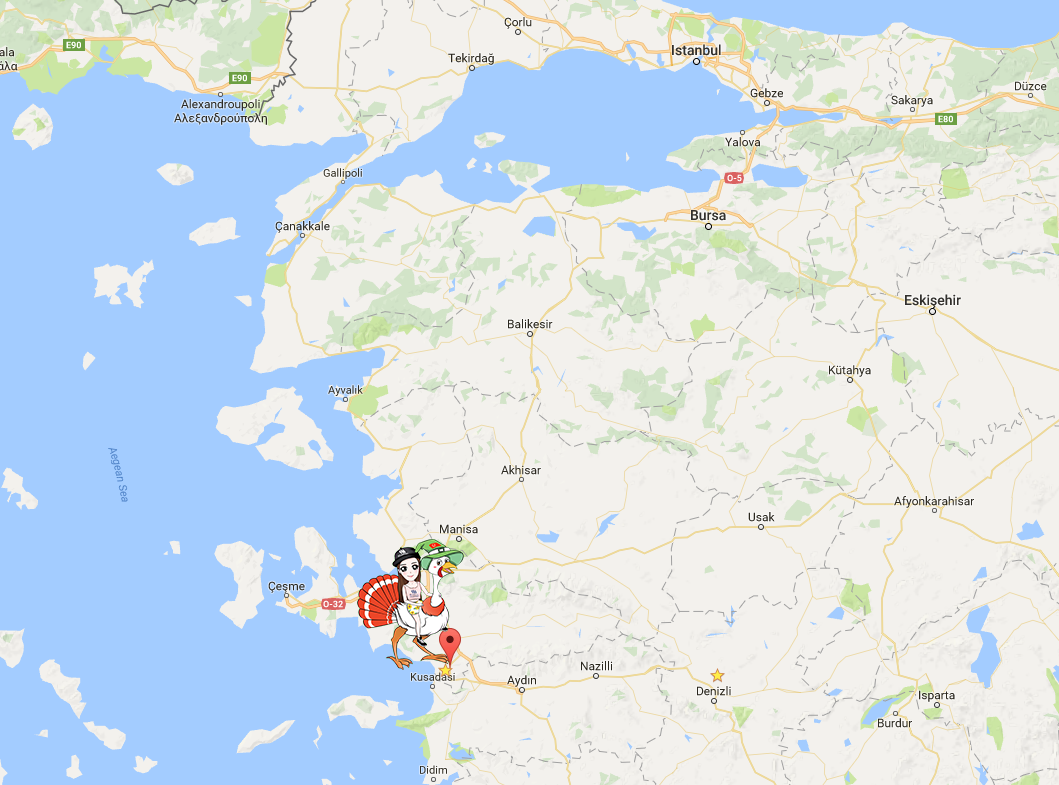
As you can see from the map, travelling from Istanbul to Selçuk is actually quite some distance. The rail network is sparsely accommodating and would take you on a fairly long detour with many long waits in between so I would not recommend it.
Should you choose to take a coach, then expect a 9 hour overnight journey which might prove to be uncomfortable but a cheaper option.
On the other hand, taking a domestic flight to Izmir and then catching a short train journey to Selçuk is the quickest albeit more expensive option. To ease your mind over the costly sounding journey, you can expect to pay around 50 dollars for the plane and train ticket and save yourself around 4 to 5 hours compared to taking the coach.
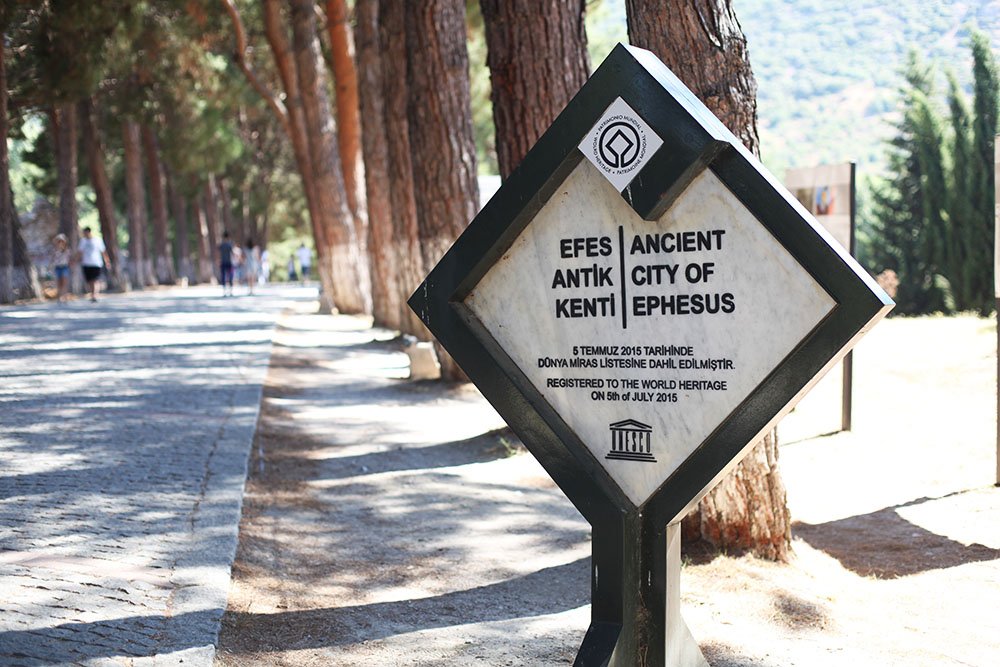
Once you arrive in Selçuk, it is then a 5 minute drive from the town centre to Ephesus for which you will have two entrances to choose from.
The North Entrance which starts at the The Bath of Varius.
The South Entrance which starts with The Theatre
Other than seeing the sites in opposite orders, the only difference between the entrances come down to your preference of going up-hill or down-hill.
At this time of year, the temperatures at midday can reach 45°C. There is very little shade from the blistering sunshine. The sensible option would be to save your energy of climbing up a hill and start at the northern entrance.
If possible, I would even recommend coming in the late afternoon when the heat subsides, I made the mistake of coming right in the middle of noon and paid the price of getting a little heat stroke.
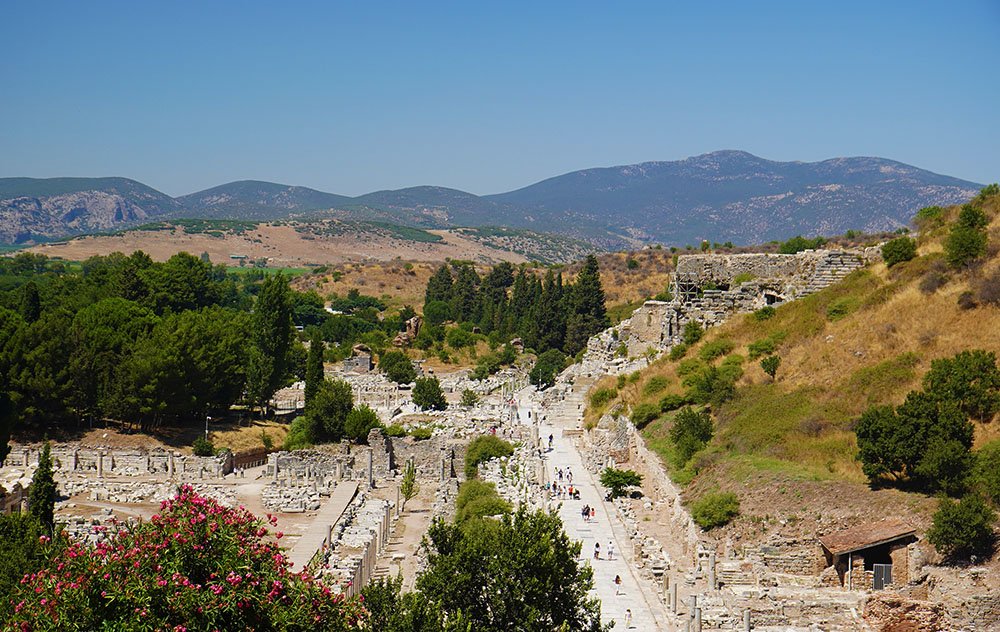
Ephesus
Ephesus is known as one of the best-preserved classical cities on the eastern Mediterranean and is an ideal place to stroll back in time and enjoy the atmosphere of life in Hellenistic and Roman times. It was once considered a commercial centre rivalling the infamous Alexandria.
Today, the city has done well to stand the test of time and there are many structures that remain mostly intact.
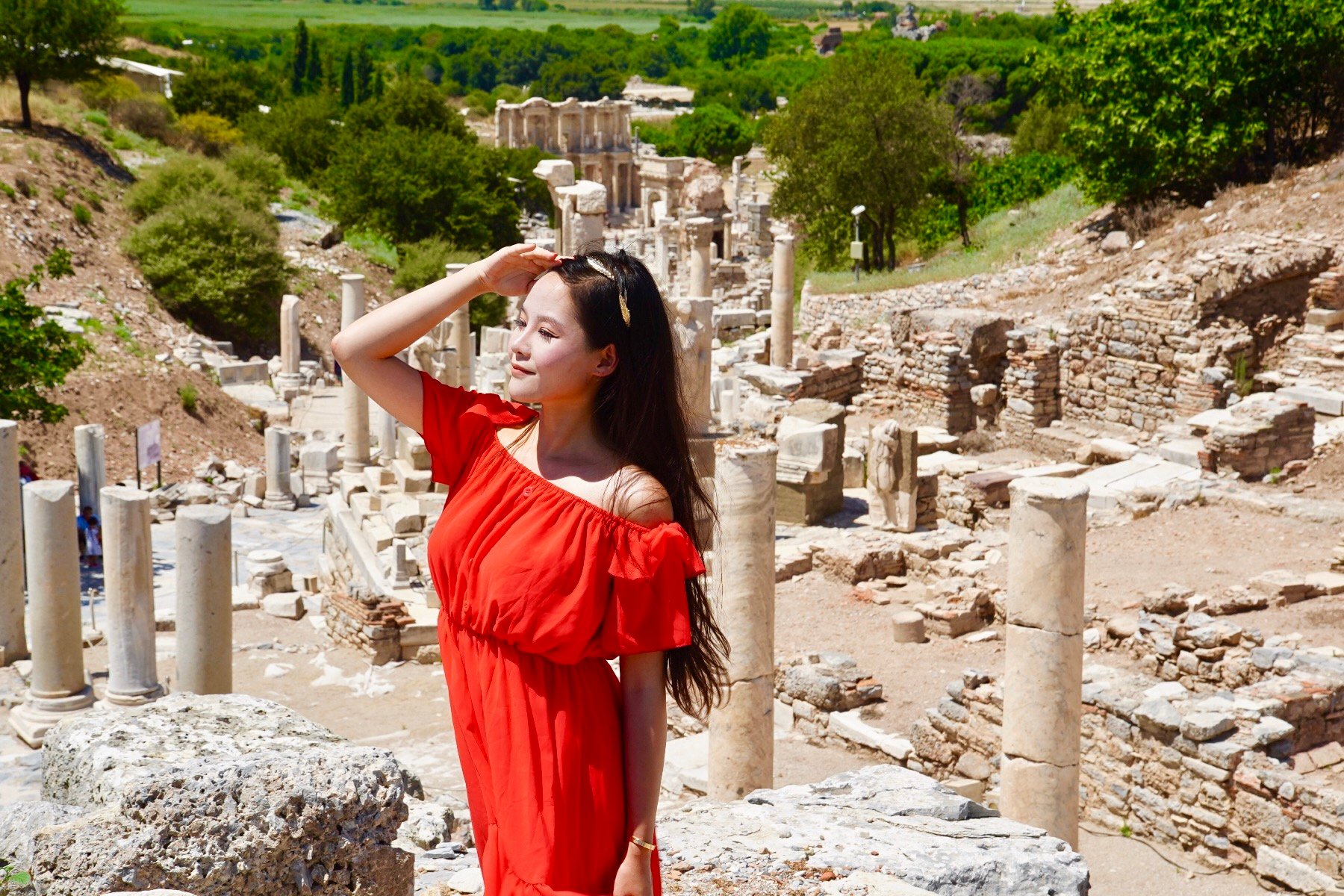
Walking along the "streets" of Ephesus, you can imagine the people of ancient times with their old carts trundling through the streets all those centuries ago.
Certainly, there is a strong sense of timelessness as you walk around.
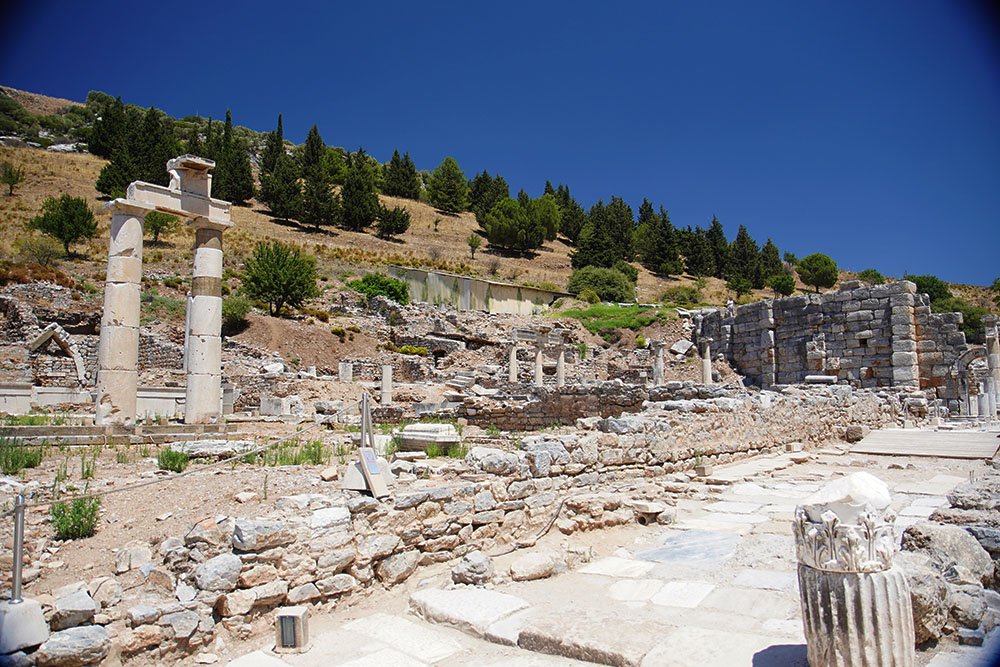
Although almost all the buildings and temples have now collapsed, many of the pillars remain standing today. They now serve as markers for the perimeters of the buildings that once stood there.

The pillars at the front are the remains of The Temples of Dea Roma and Divus Julius. This was a temple erected in the 1st century for use by the Imperial Cult - a religious sect which never became truly recognised. Originally it was formed as a mission to unite the various religions amongst the people of the city.
Just behind the front pillars, you can see the remains of The Prytaneion which was the administrative building or city hall. This would have been used for welcoming visitors of the state, as well as meetings between officials.
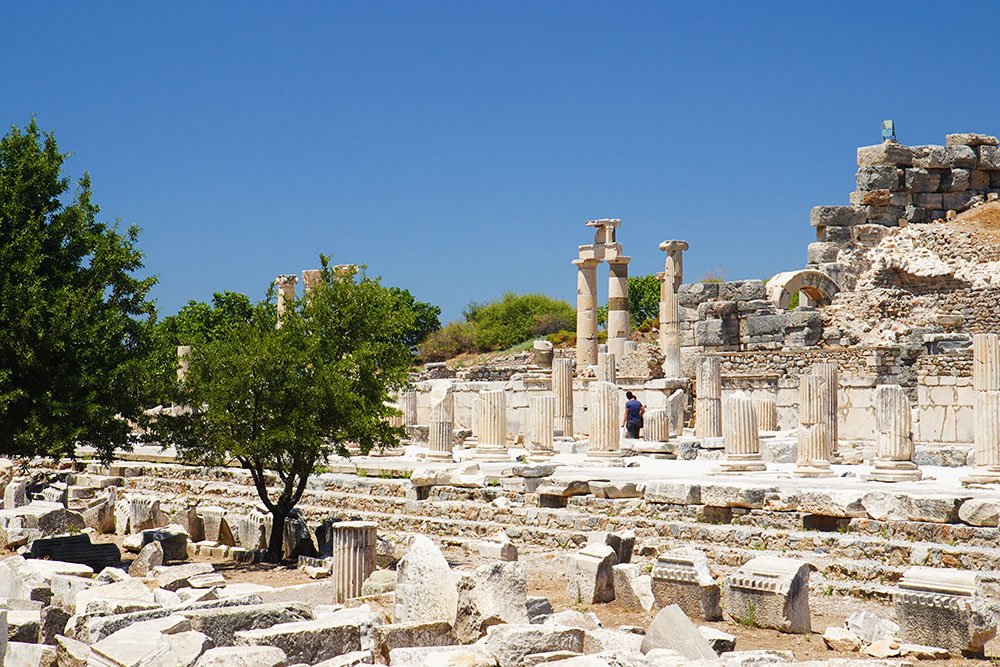
This is the Memmius Monument, a sizeable memorial dedicated to Memmius son of Caius and grandson of Sulla.
I believe the partially intact stone statue on the side is of Memmius.
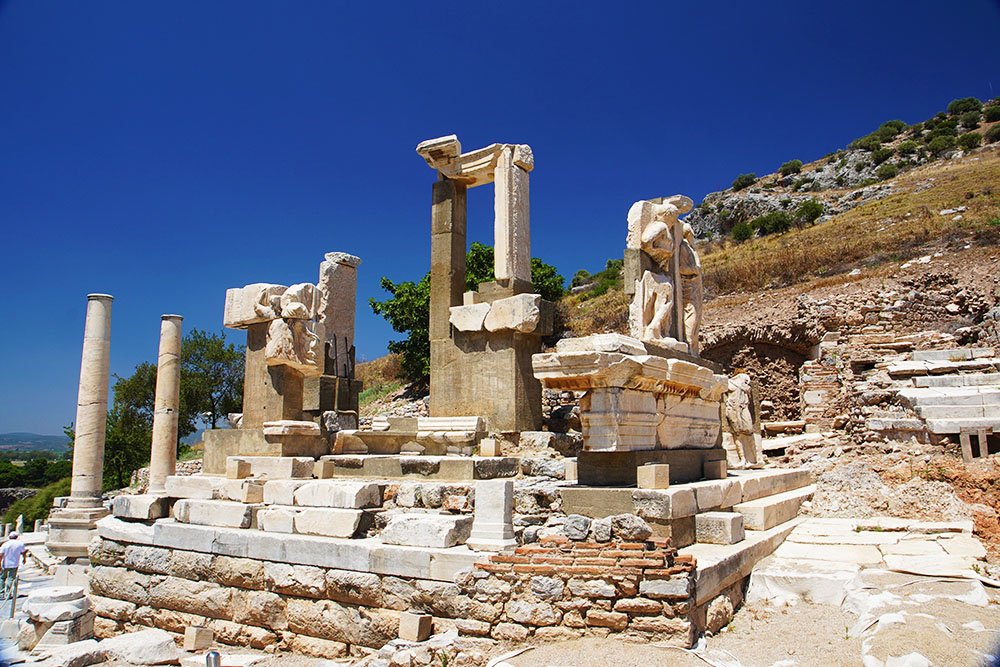
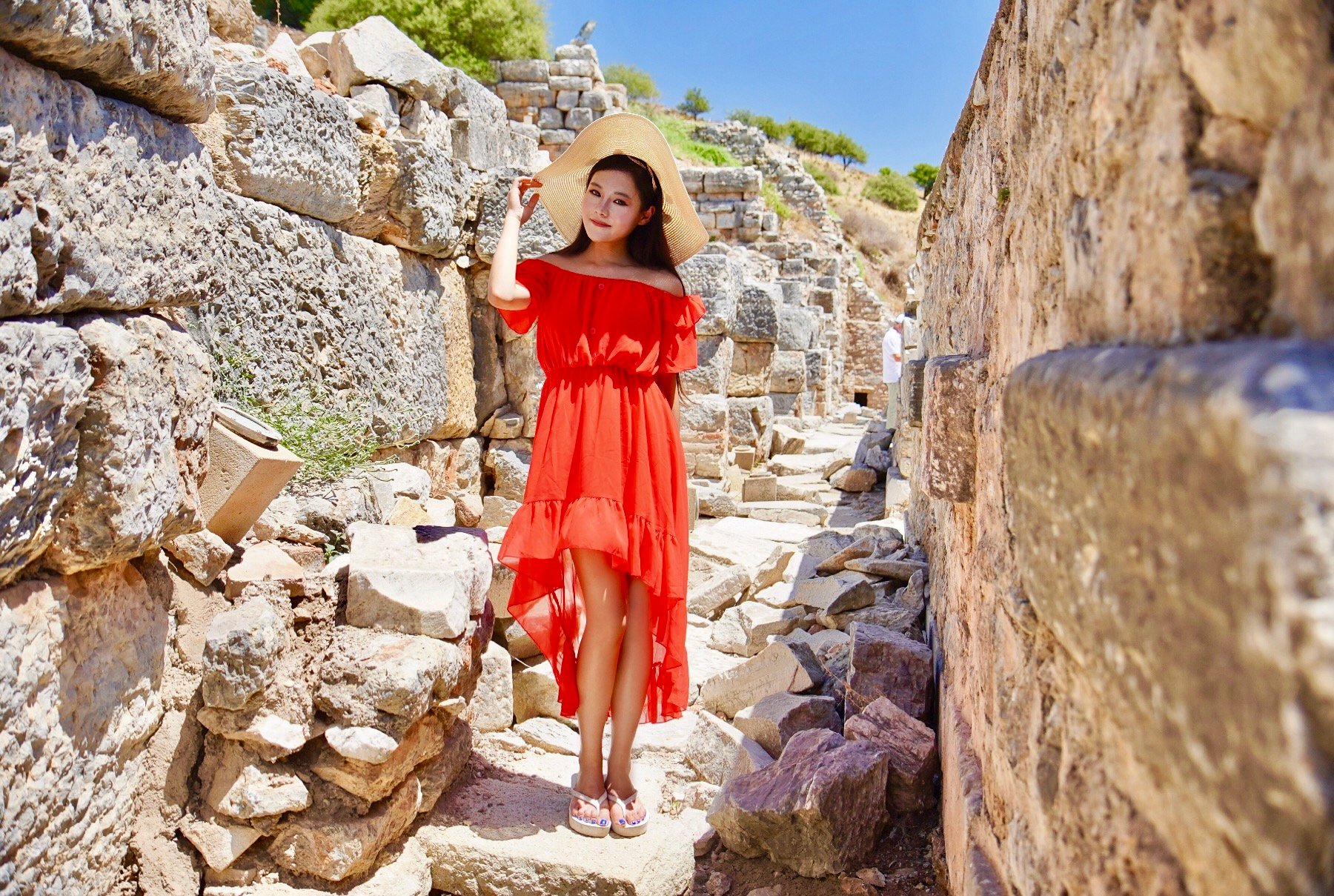
In the distance, you can make out the two pillars which would have been the entrance to The Domitian Temple. This temple was believed to be the first temple of the cult of emperors in Ephesus.
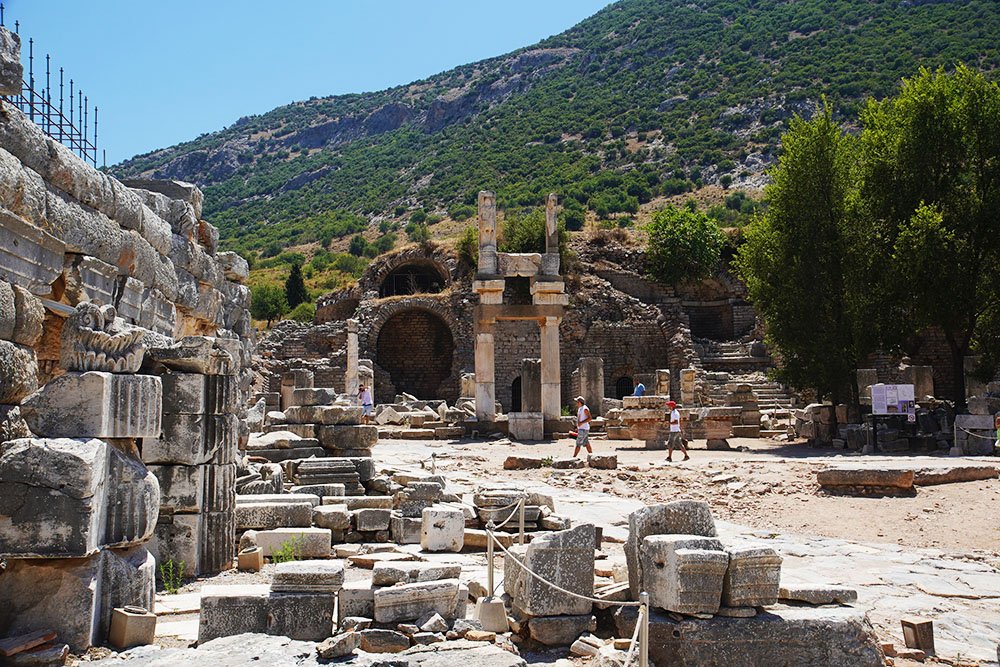
As required in all cities, ancient or modern, our long time cat companions. This was just one of the many cats I saw snoozing in the shade, hiding from the blistering heat. I do wonder whether the cats around here could trace their family tree all the way back to the ancient times. A passing thought!
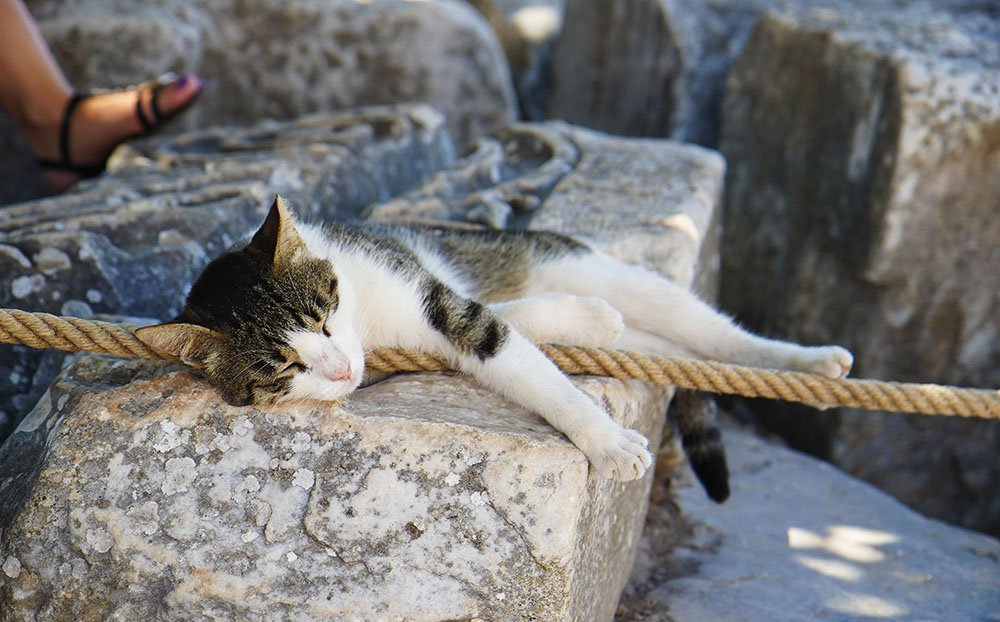
All around, we see some really detailed excavations of some historical figures, or mythic legends.
This is the Greek goddess of Victory - Nike!
She is often called the Winged Goddess for obvious reasons!

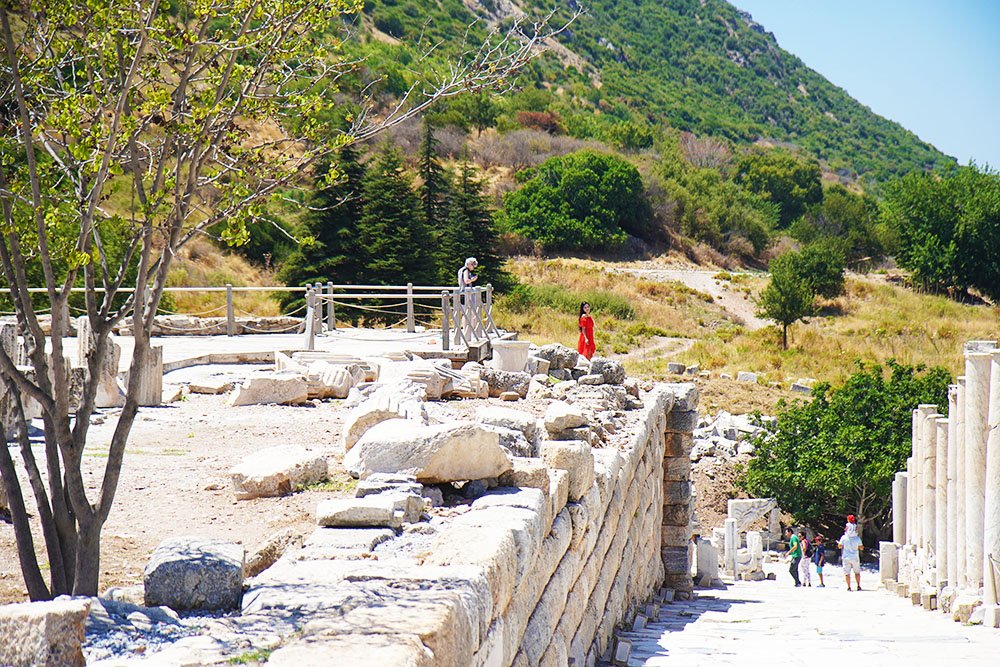
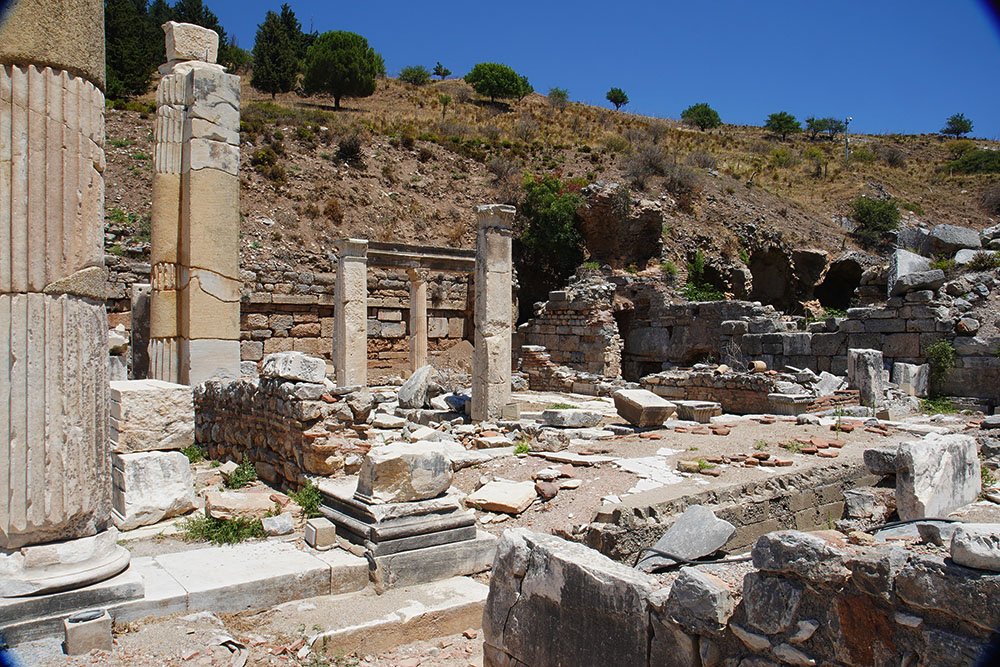
The Odeon
As shown by the sign-post, the Odeon was used as a concert hall theatre, but actually had a second function as the Bouleterion (Senate House). Here, the senate and advisory council of the city would congregate and discuss city matters.
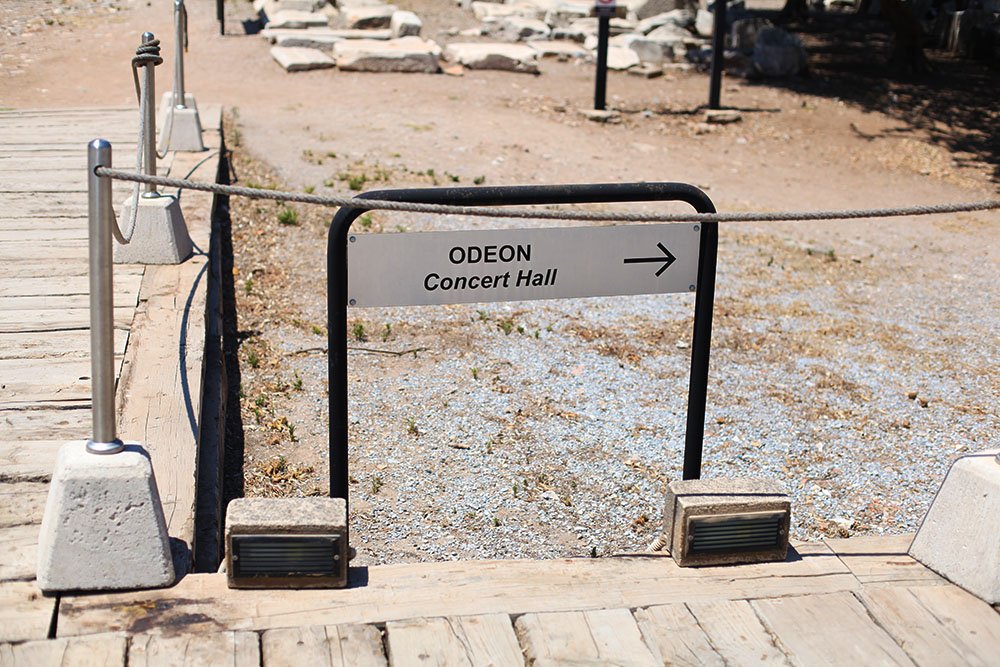
Theatres built by the ancient Greeks and ancient Romans were usually semi-circles, aside from congregational meetings, they were also used for performances. This is in contrast to the Amphitheatres which were used for Gladiator combats and were fully circular in shape.
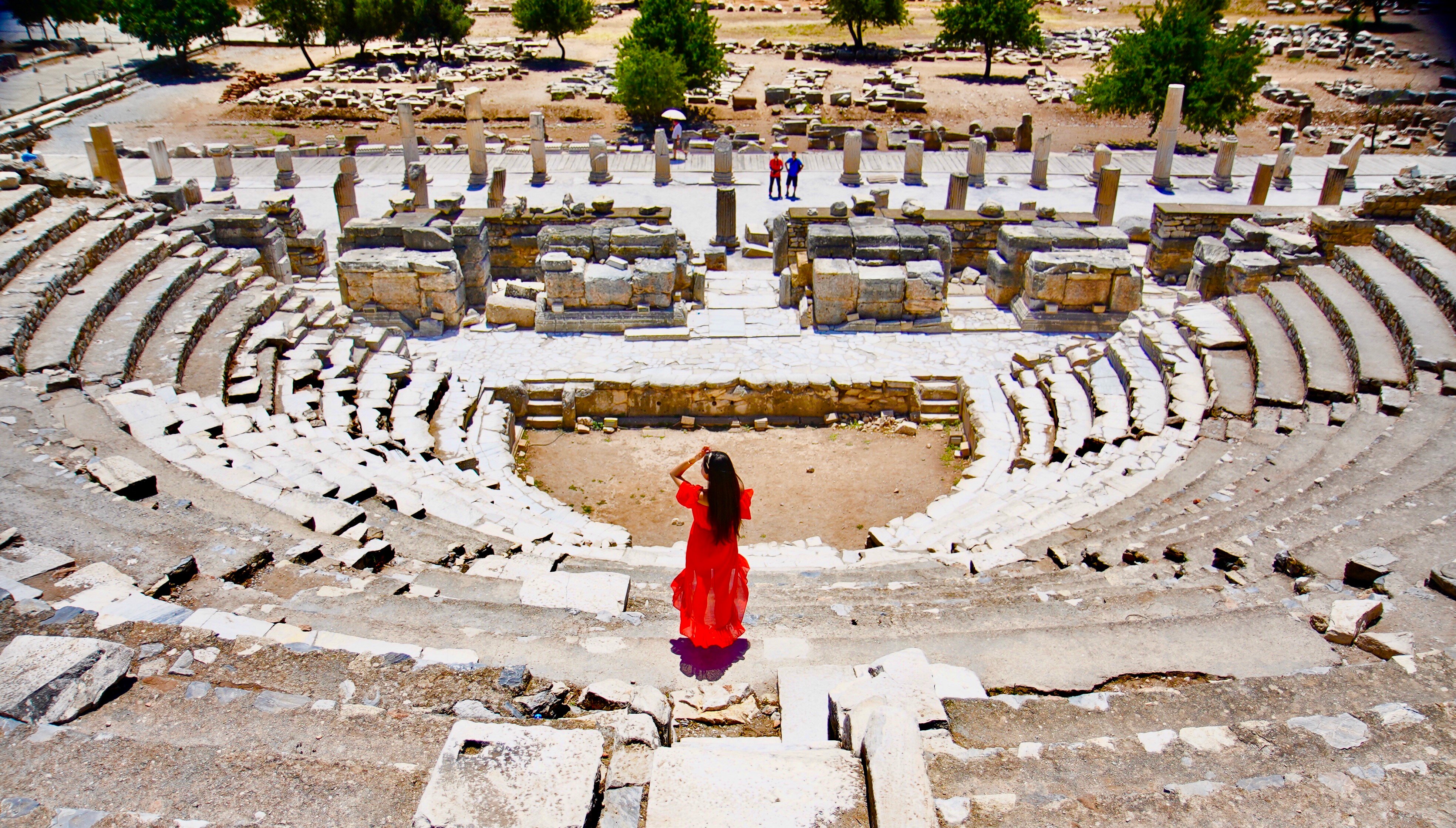
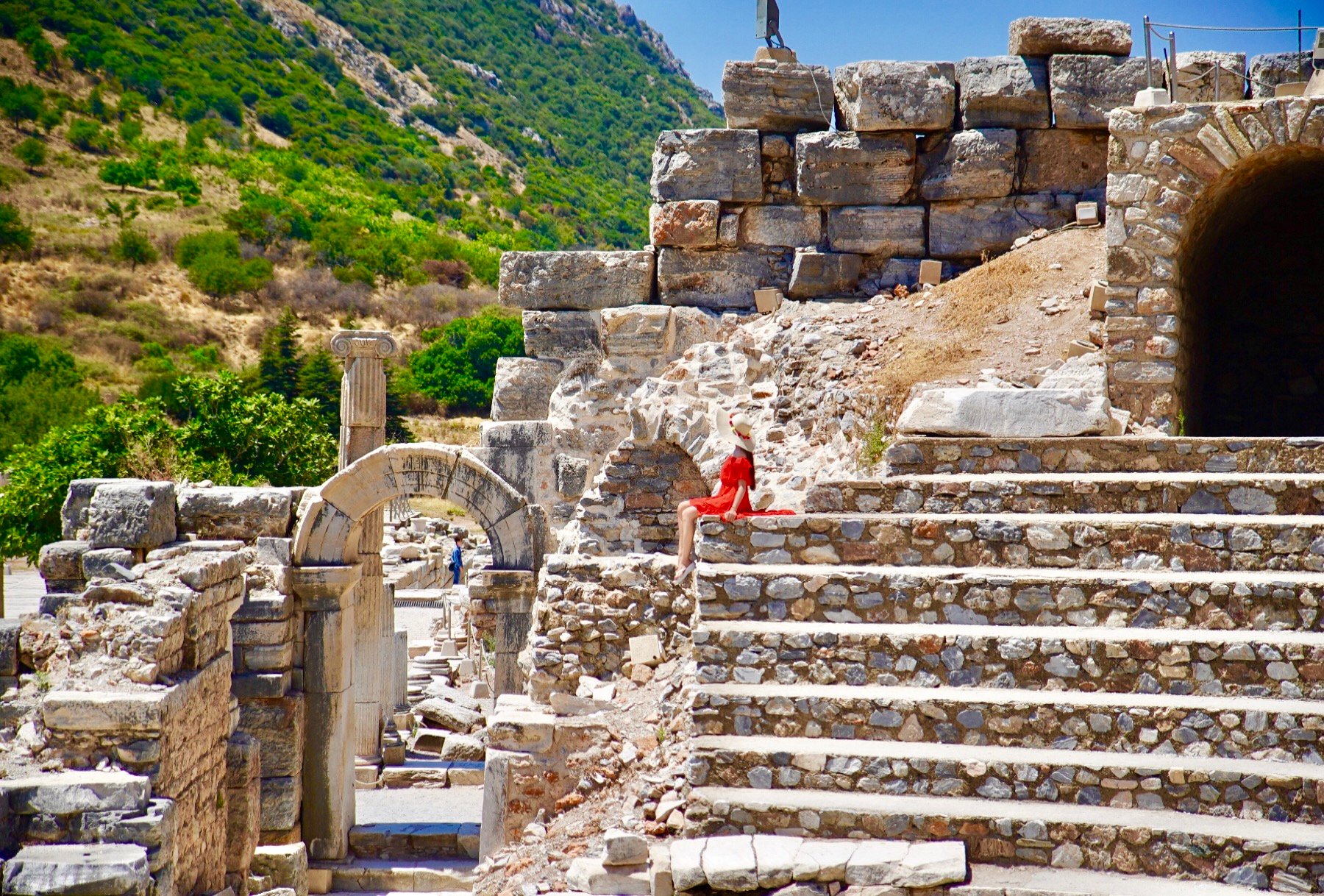
Further along from the Odeon, we reach Curetes Street which starts with the Hercules Gate, and ends at the Celsus Library.
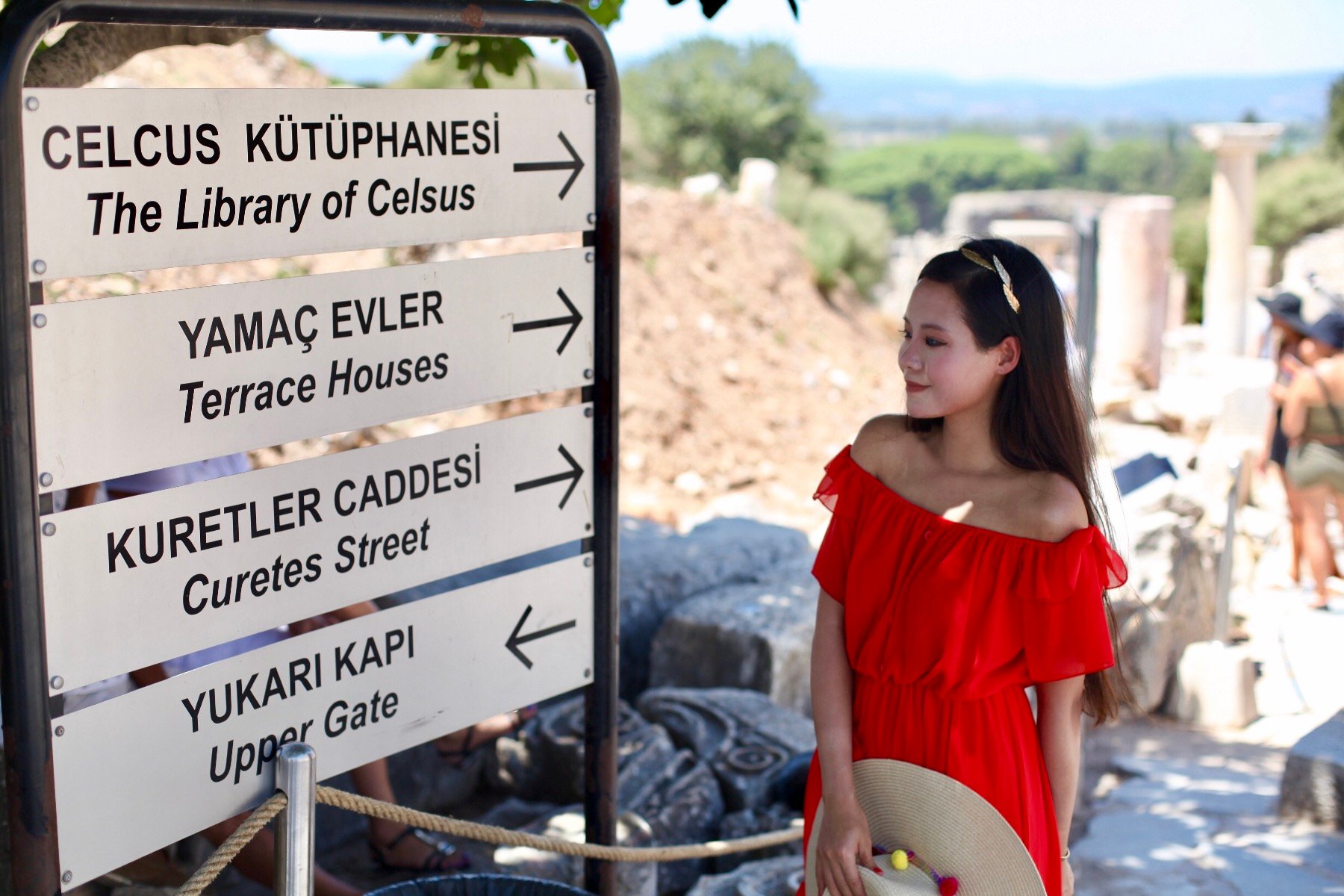
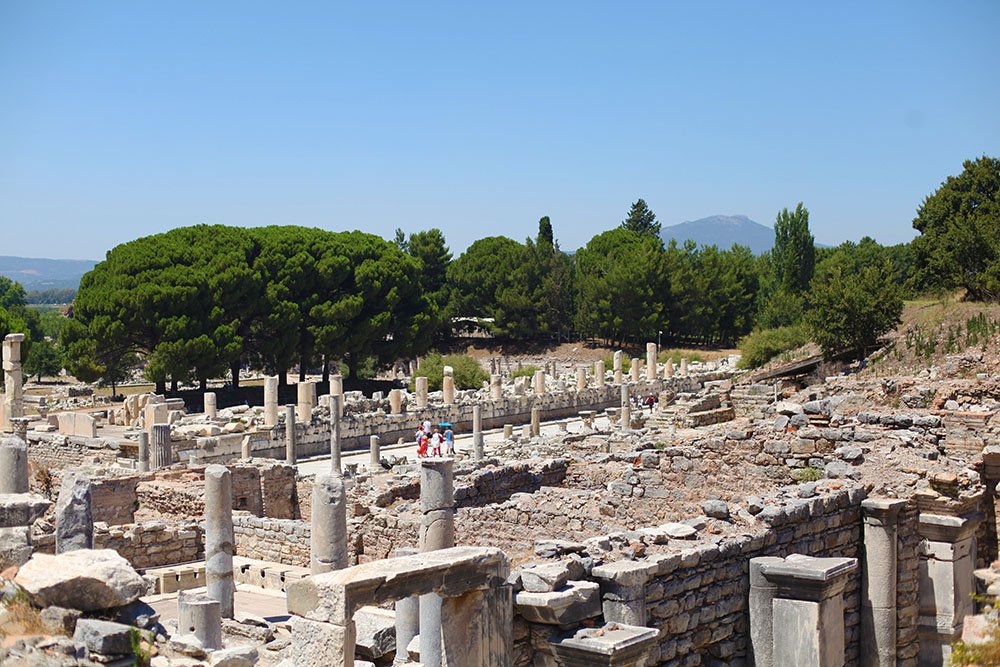
The Curetes Street would have had fountains, monuments, statues and shops on either sides. Even when the city was still inhabited in the ancient times, earthquakes were frequent and as a result, many of the structures on the street were damaged.
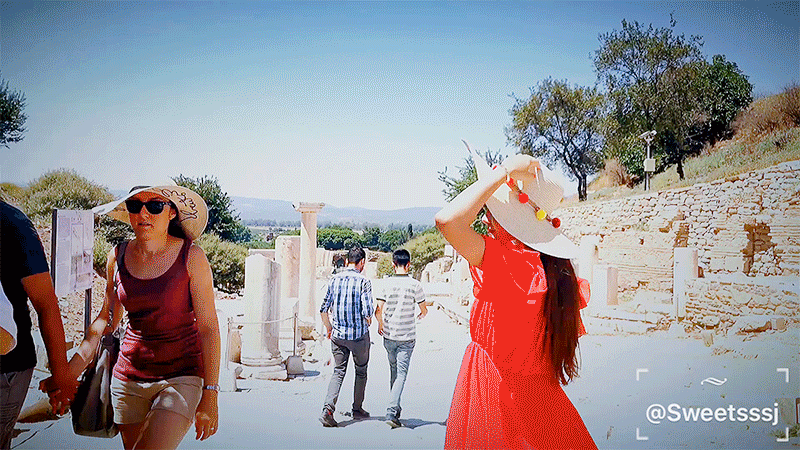
These were some of the houses people used to live in.
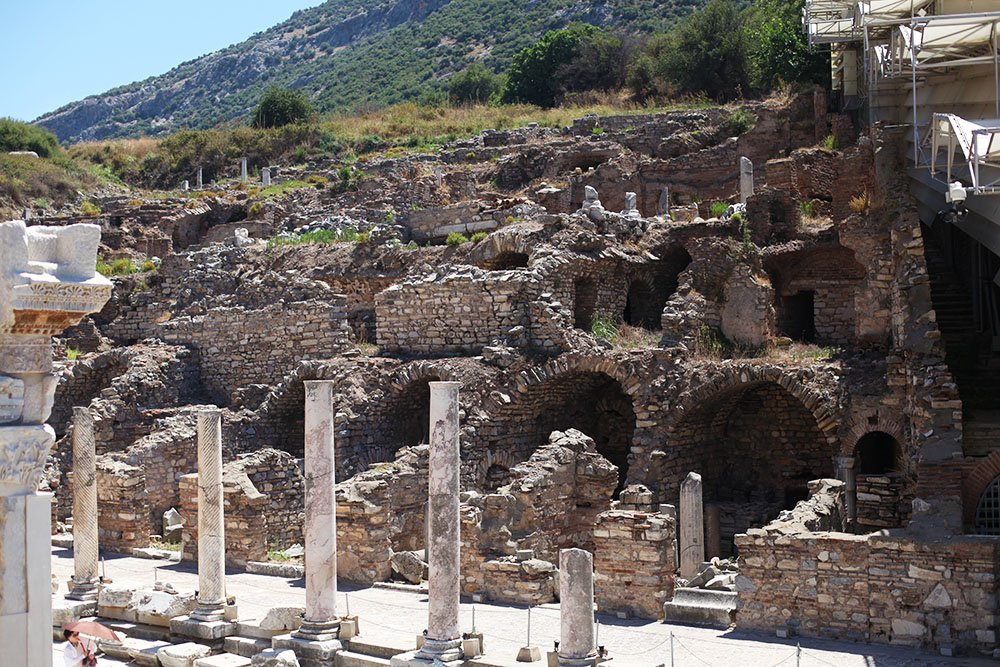
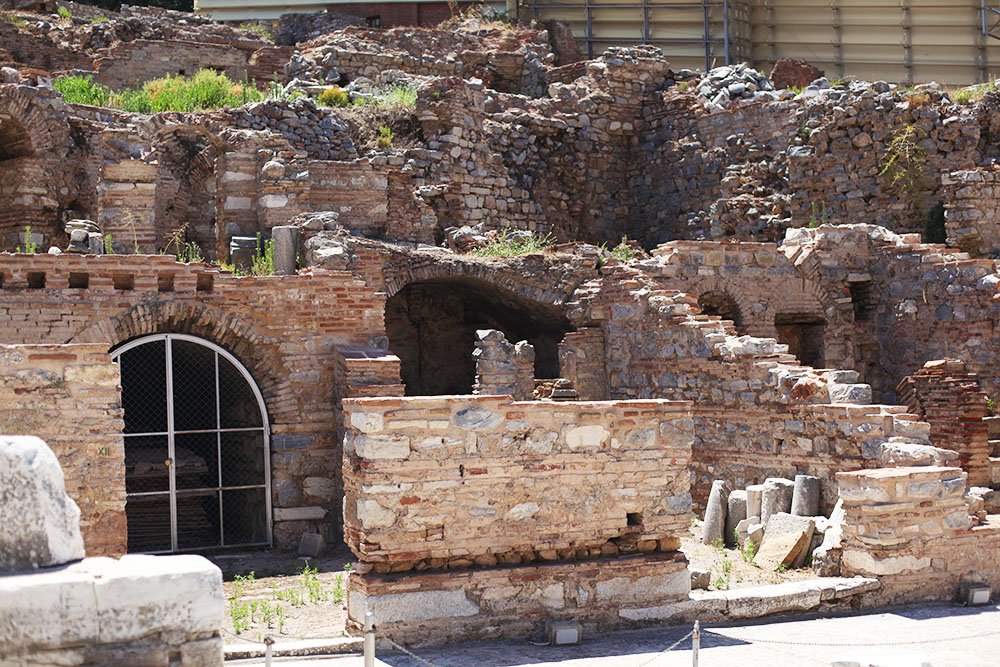
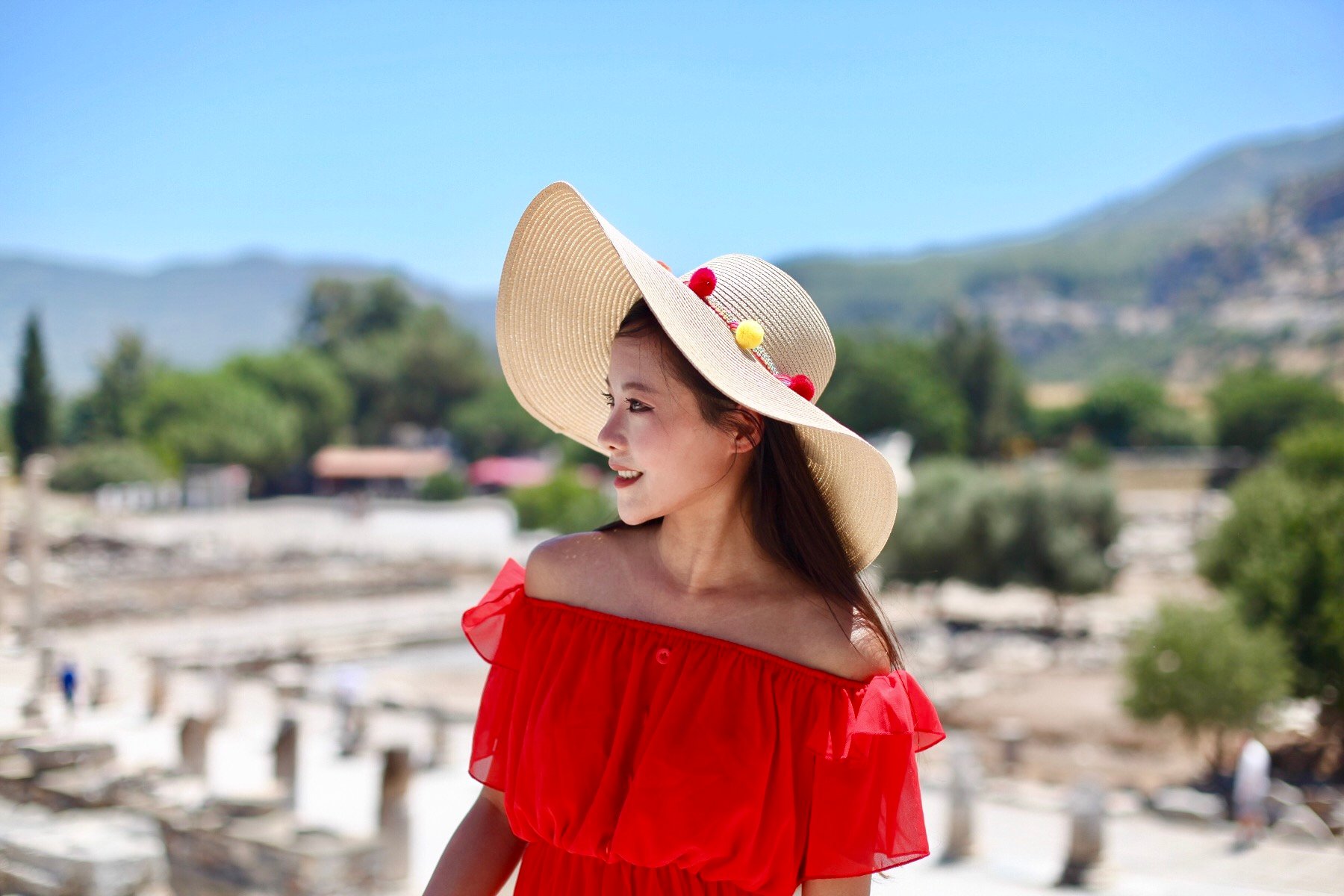
This is a closer look at the Domitian Temple. Parts of a huge statue were excavated and thought to be that of the Emperor Domitian.
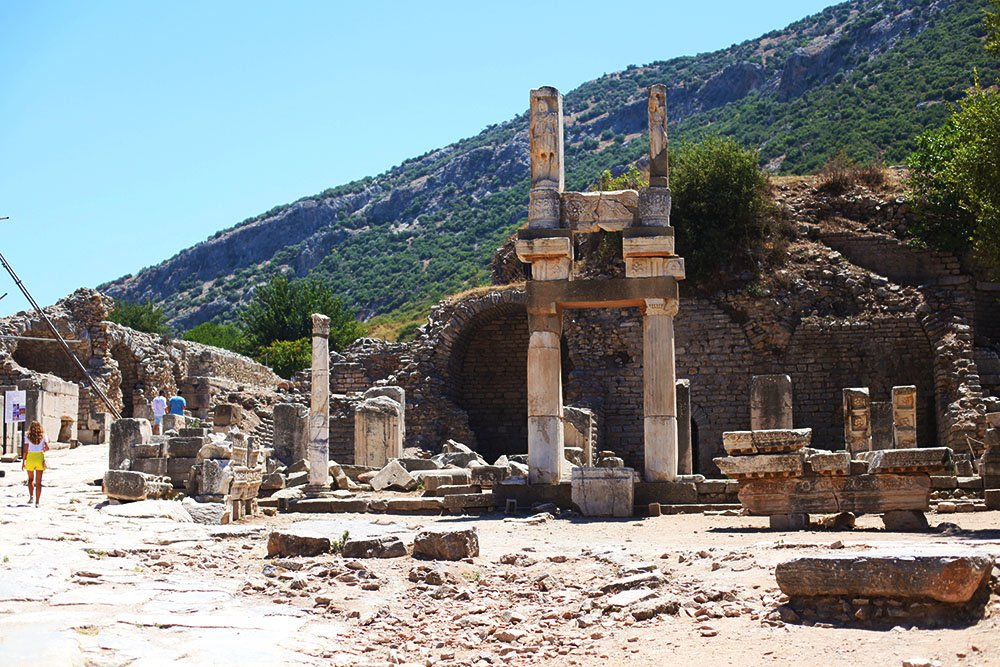
The Nymphaeum of Trajan. This was a two story building which was built in honour of the Roman Emperor Trajan. The building had it's own private pool with water cascading from beneath a statue of the emperor.
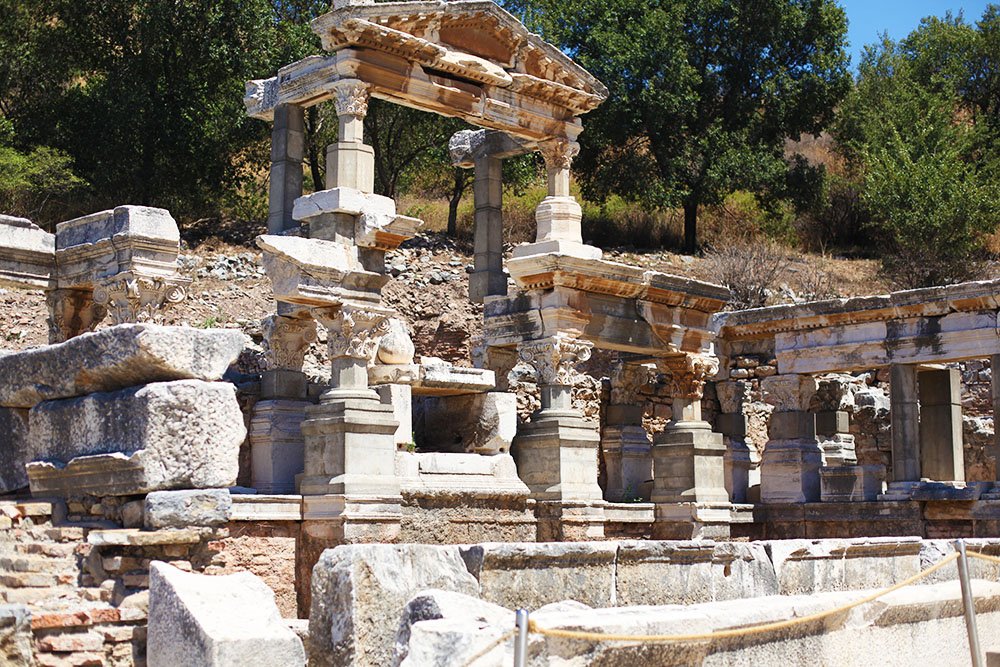
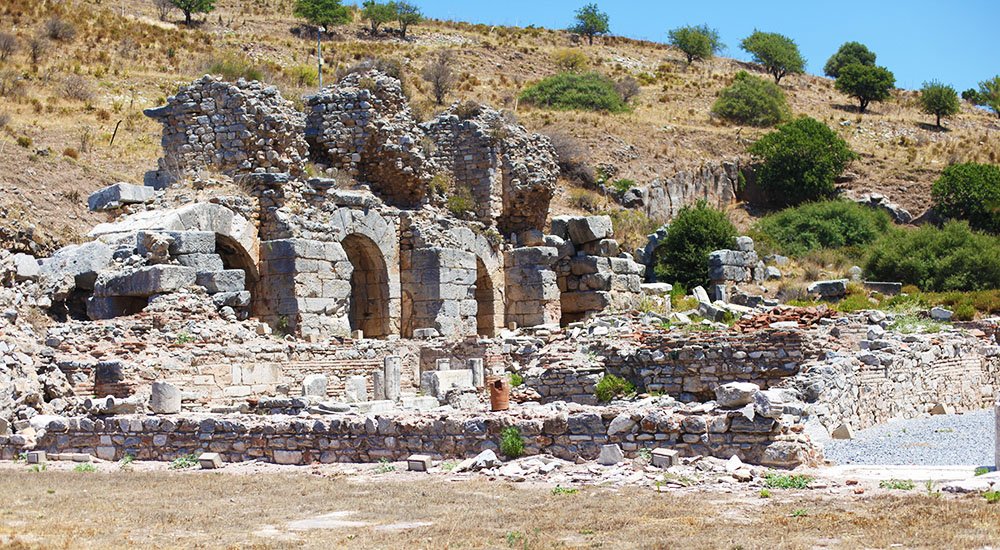
The Hadrian Temple

The Terrace Houses
These were the dwellings of the rich people of Ephesus. The pictures below show many of the houses to be three stories tall, and many had their own courtyards. Interestingly, most of the rooms were without windows.
On the ground, there are intricate mosaics of mythological scenes.
It's hard to believe, but aside from these private houses being furnished to the highest standard, they were also fitted with fountains and even "central heating"!
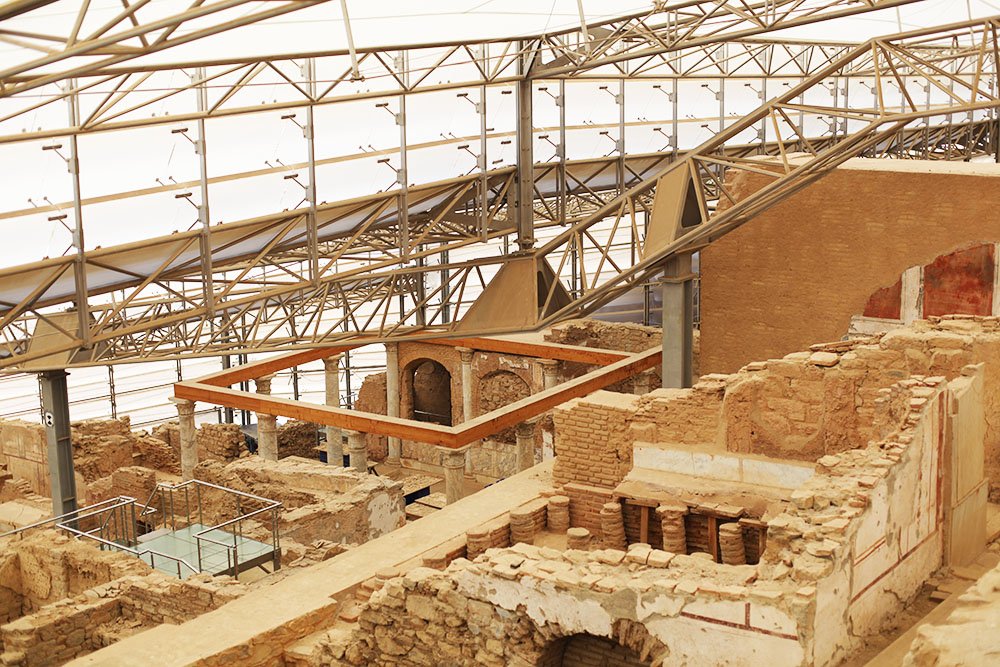
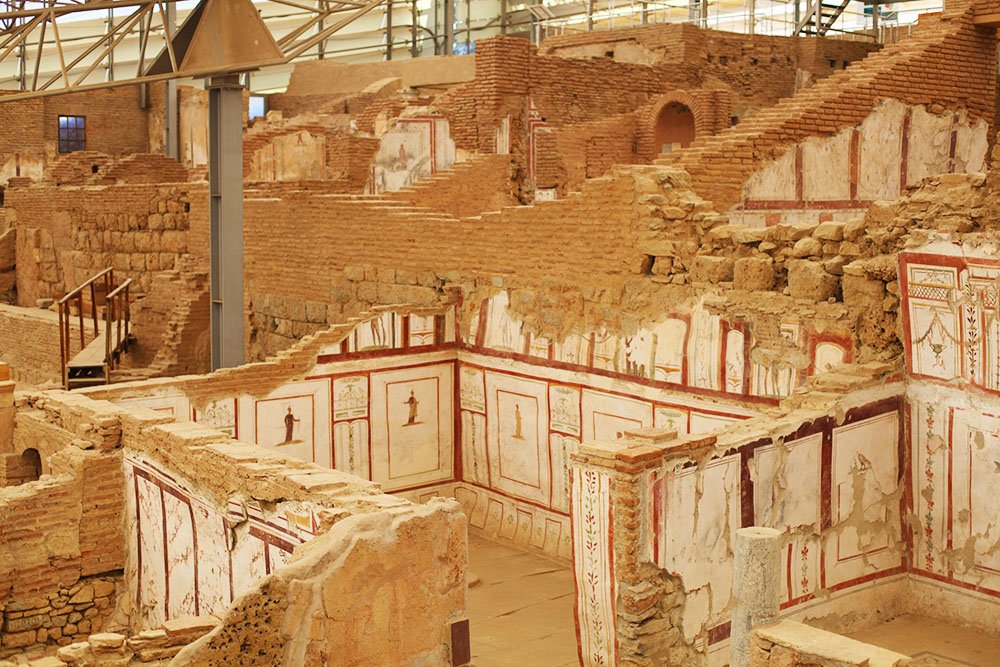
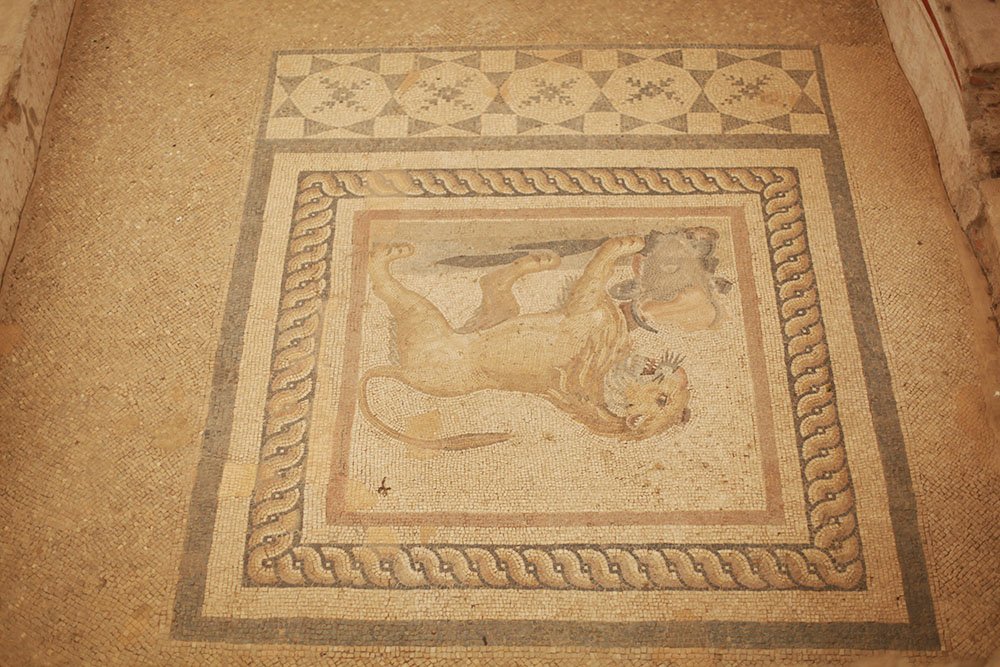
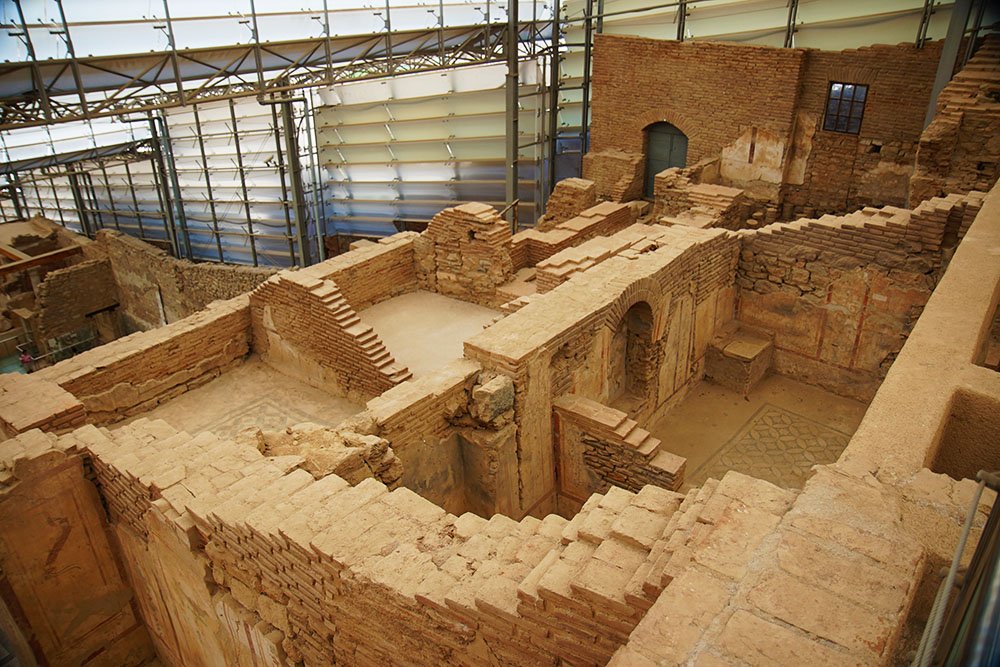
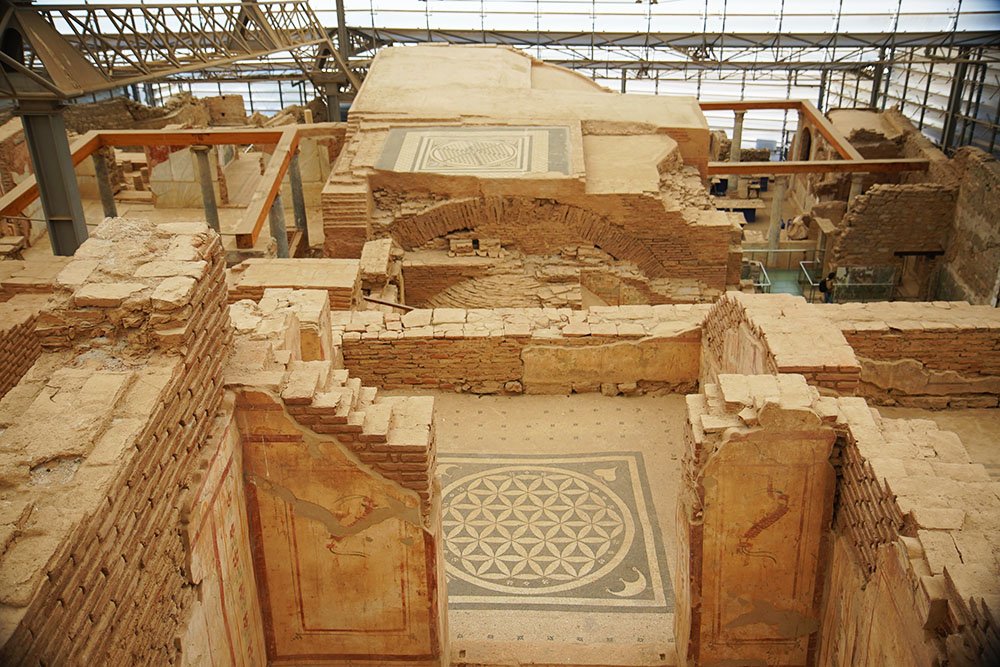

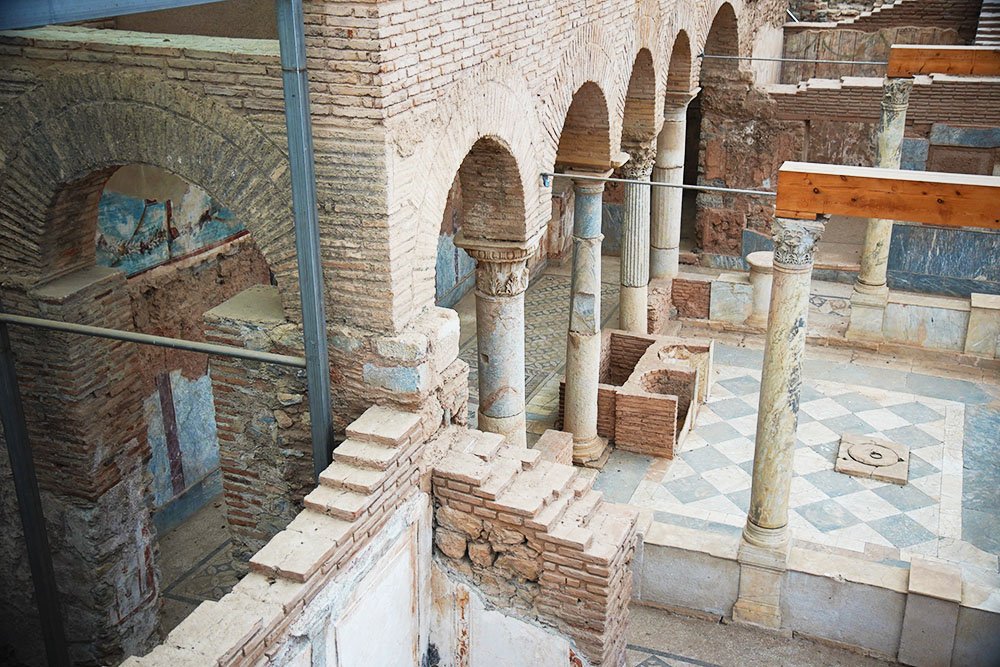
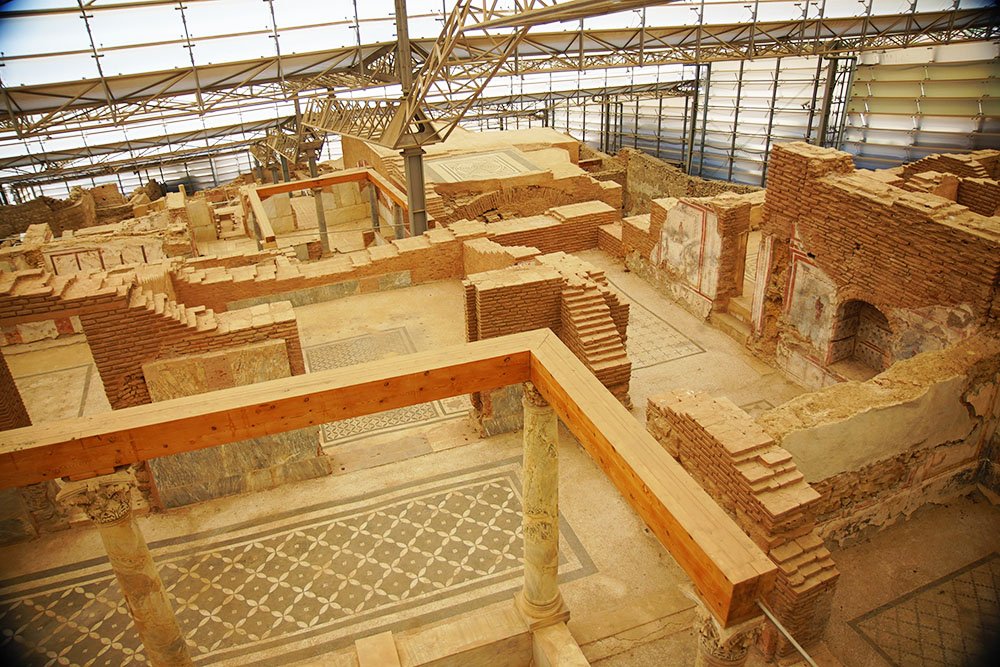
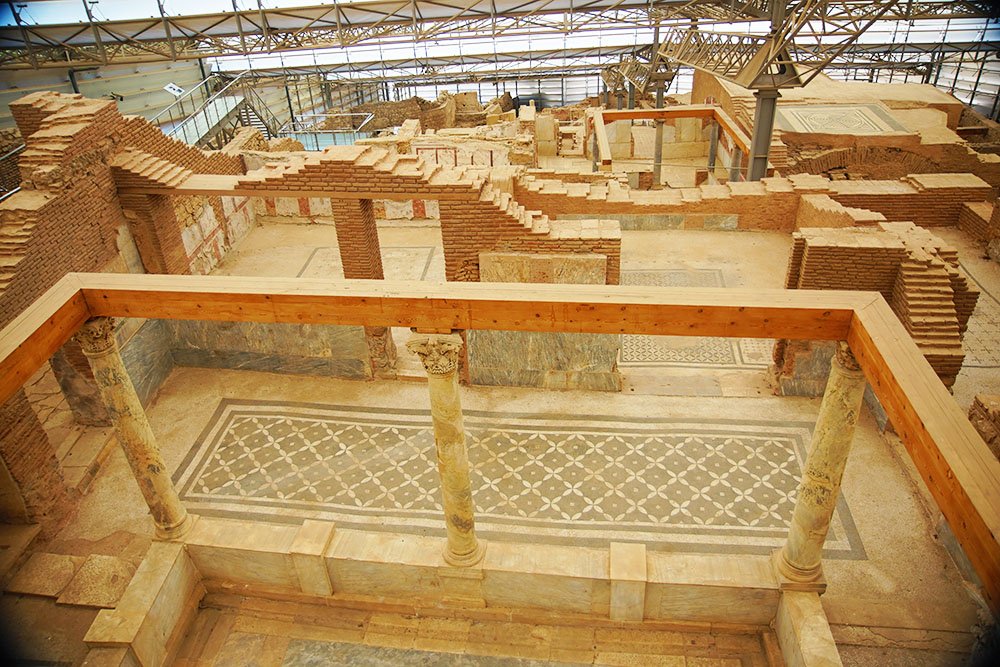
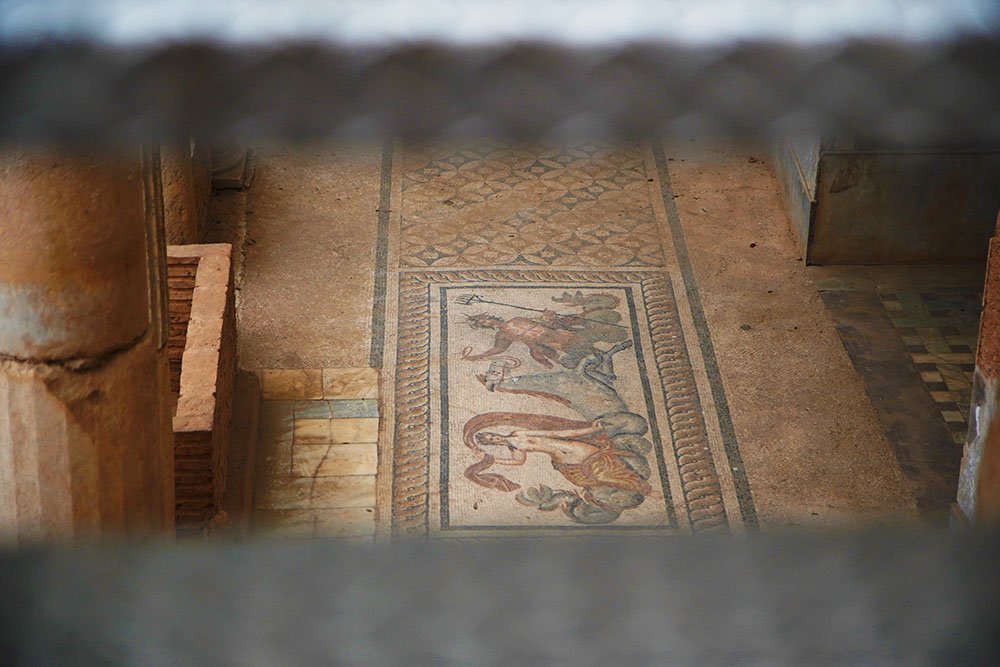
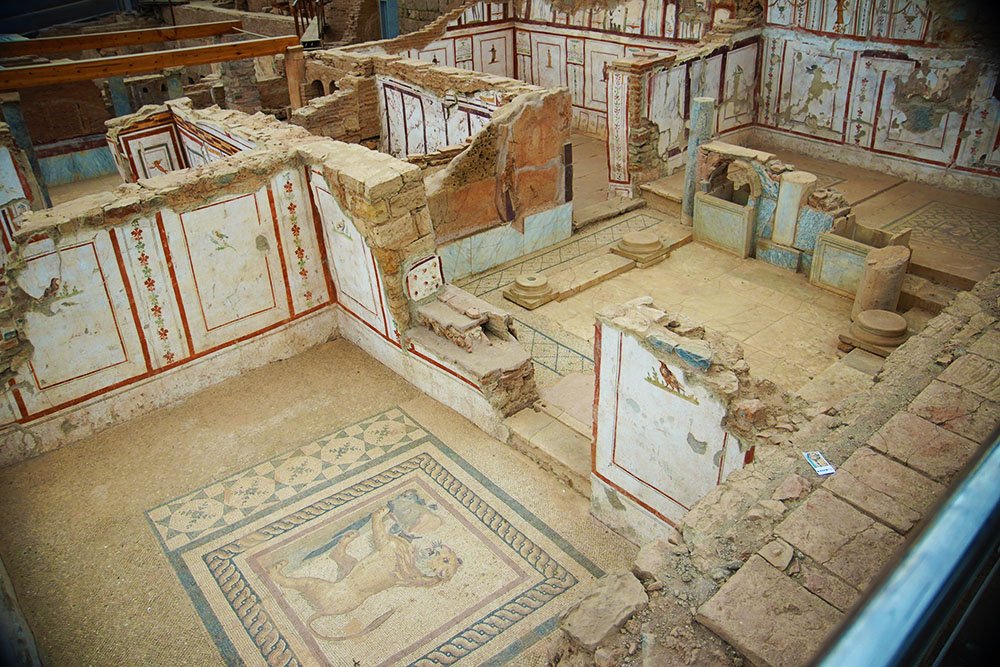
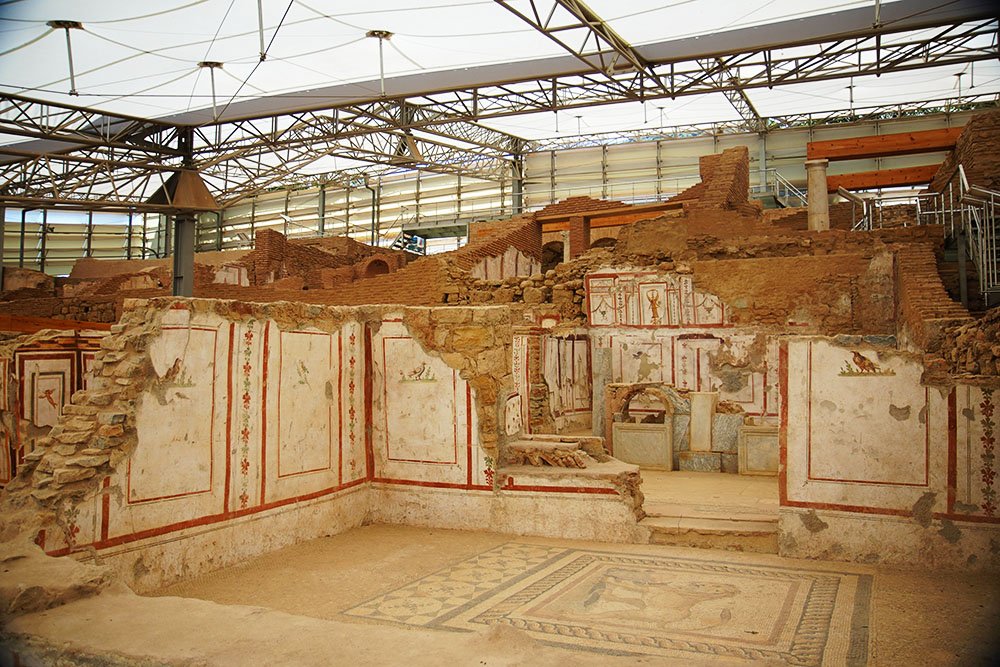
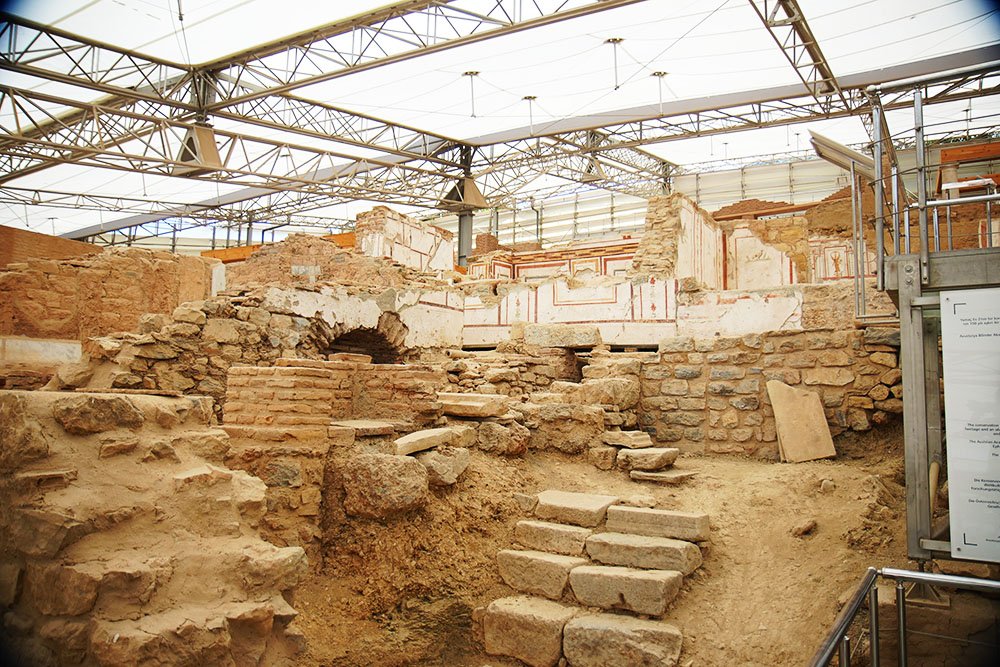
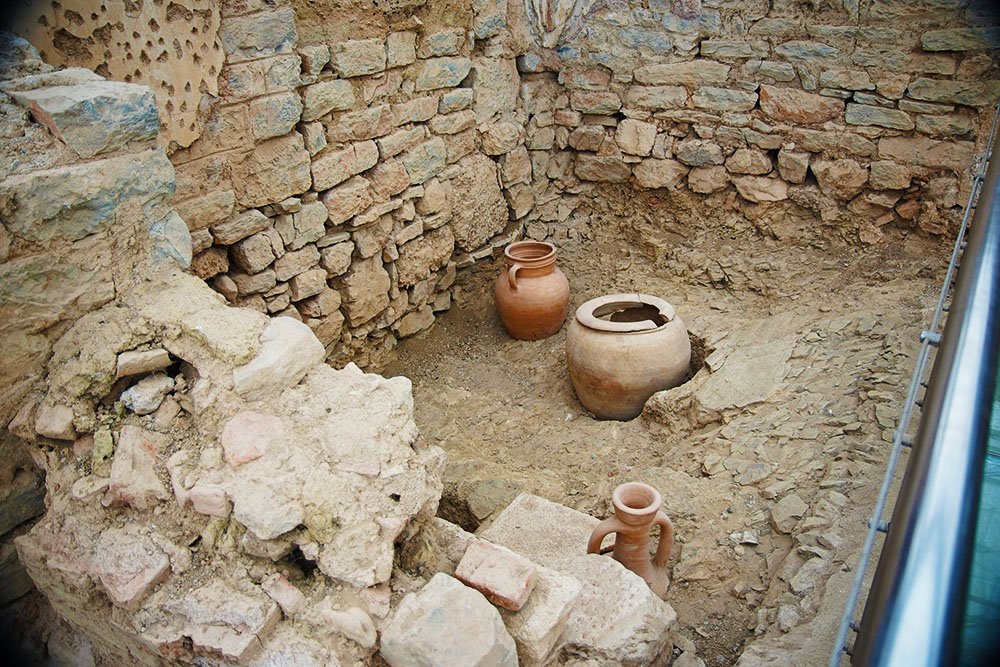
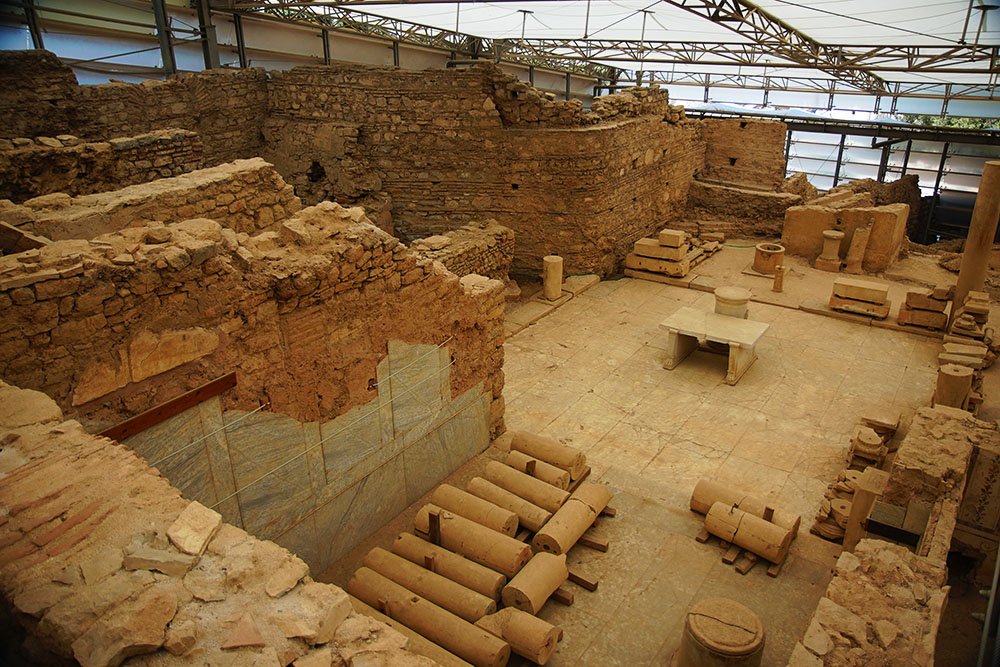
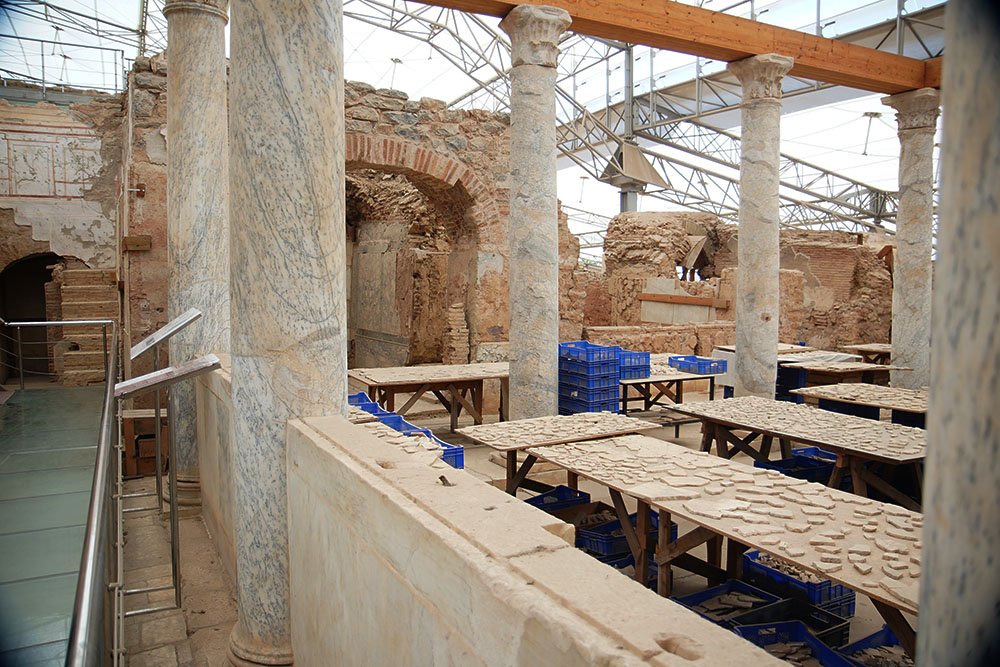
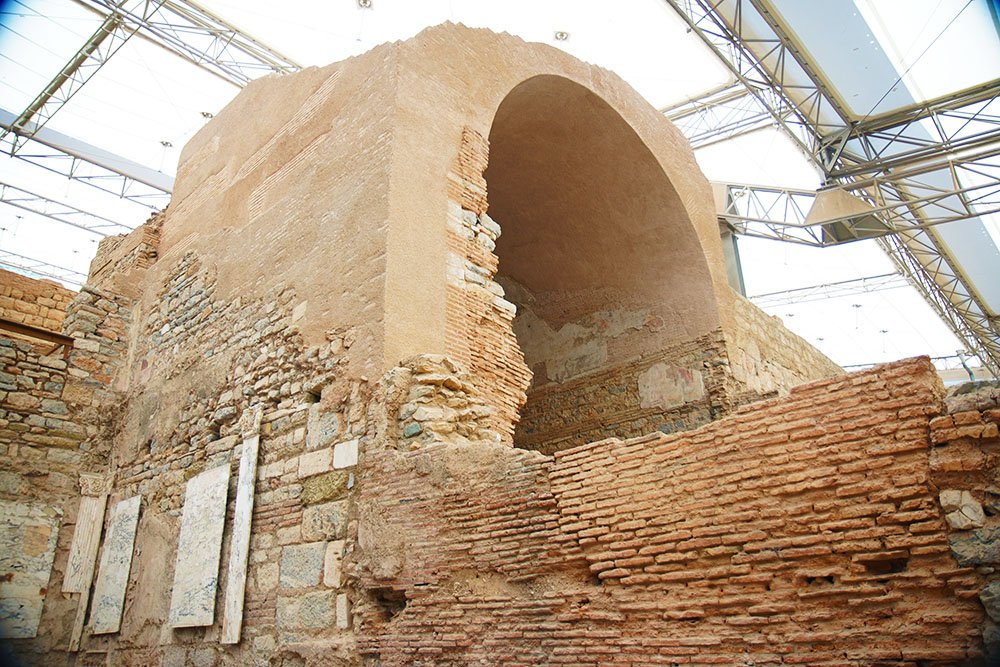
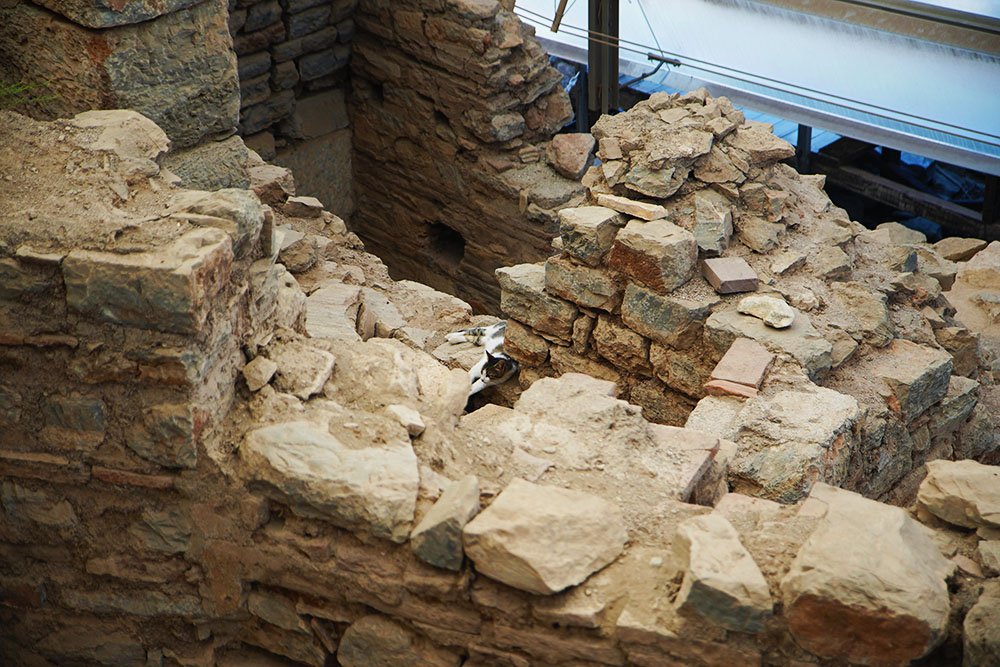
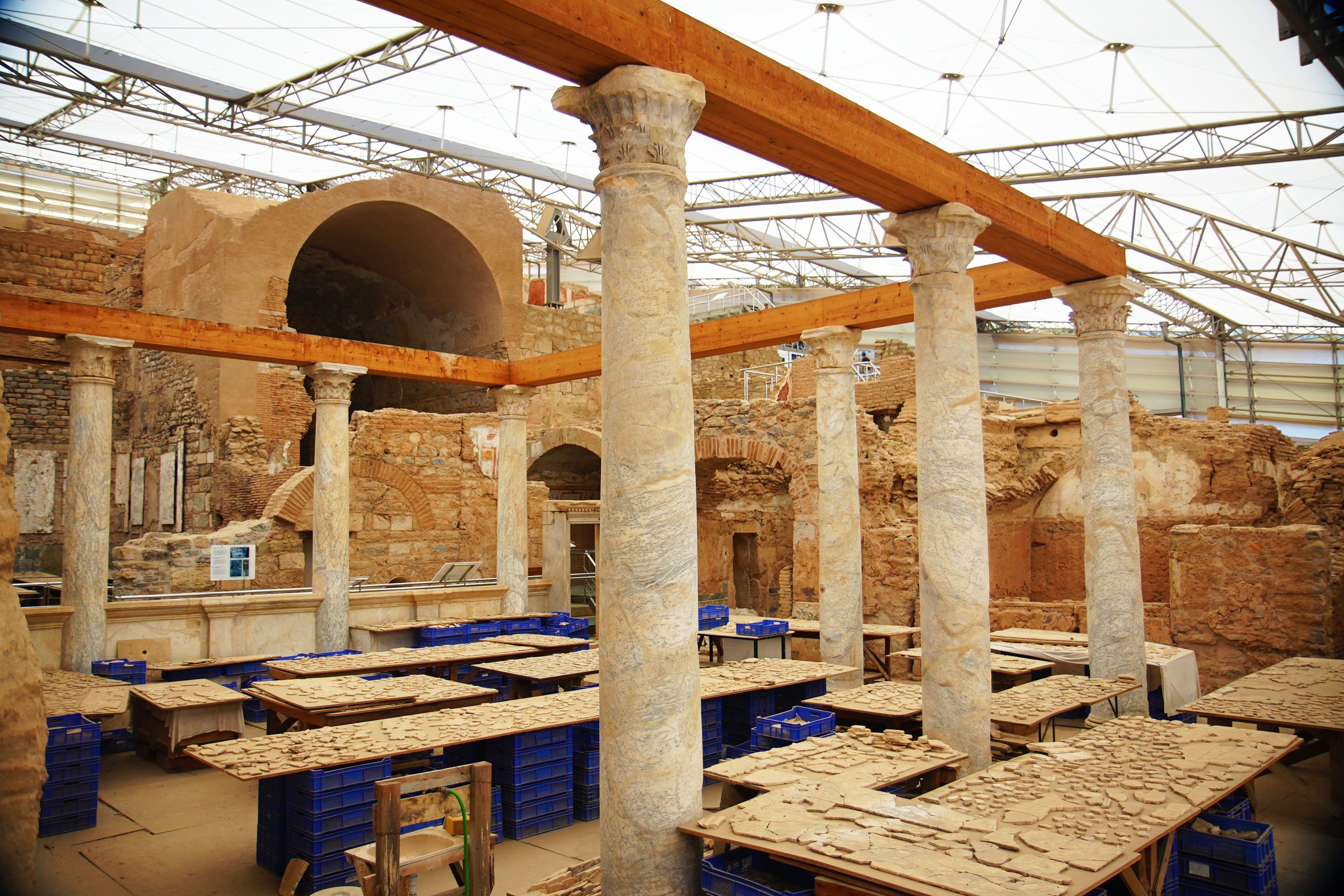


The Celsus Library
As you can see, it is situated at the end of the Curetes Street and is one of the most complete structures left standing in Ephesus.
The Celsus Library was the third largest library in the ancient world and was built by Gaius Julius Aquila as a tribute memorial to his father, Gaius Julius Celsus Polemaeanus.
To this day, the sarcophagus of Celsus lies in the crypt beneath the building.
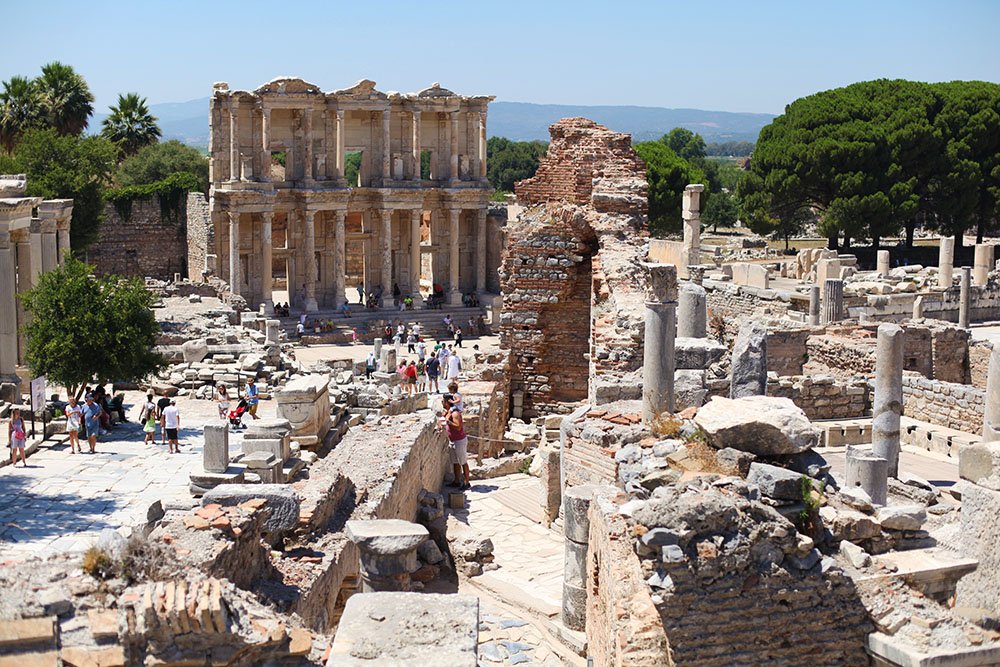
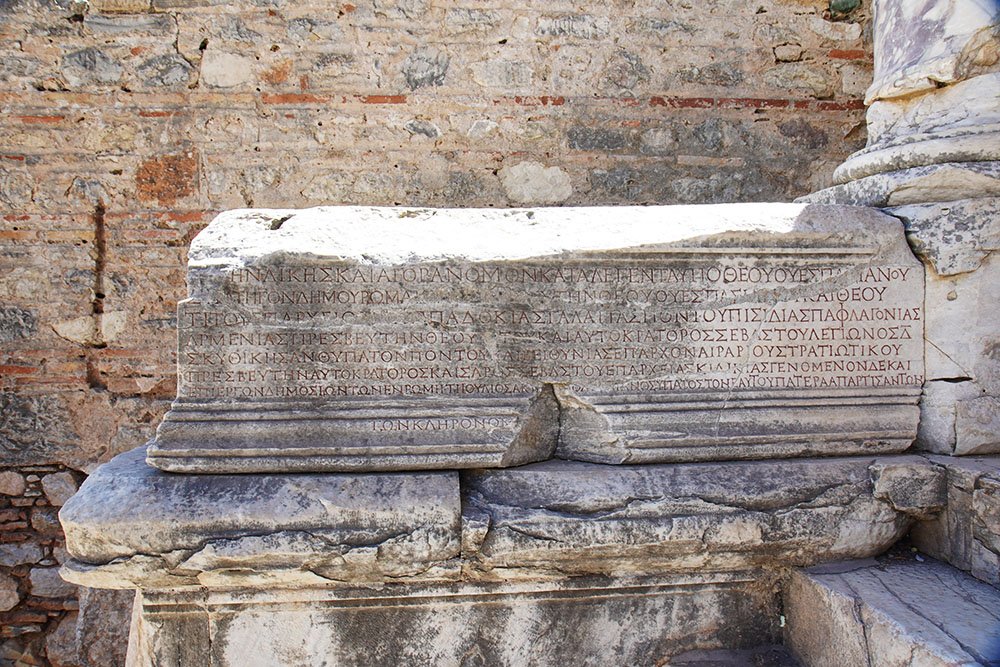
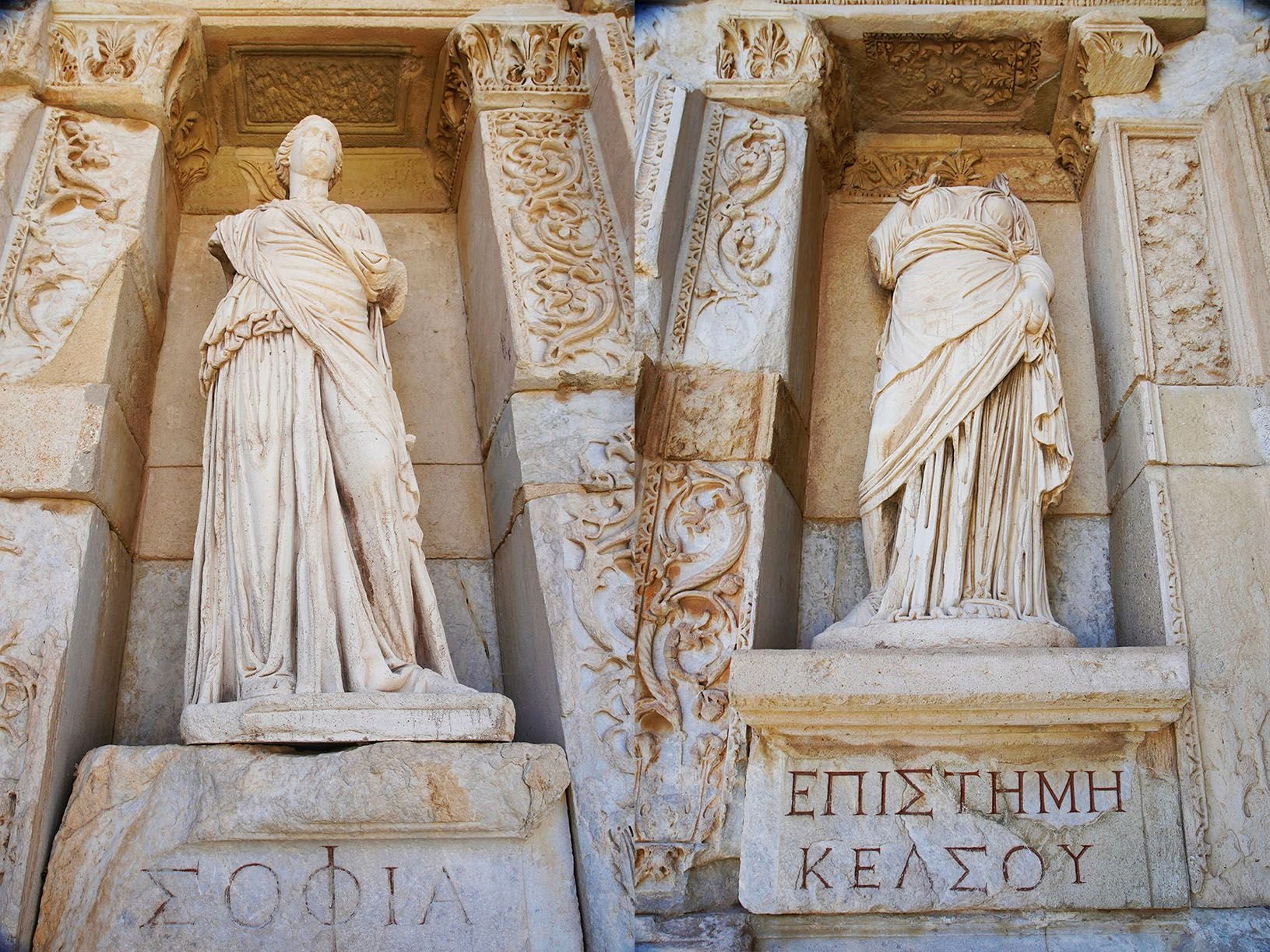

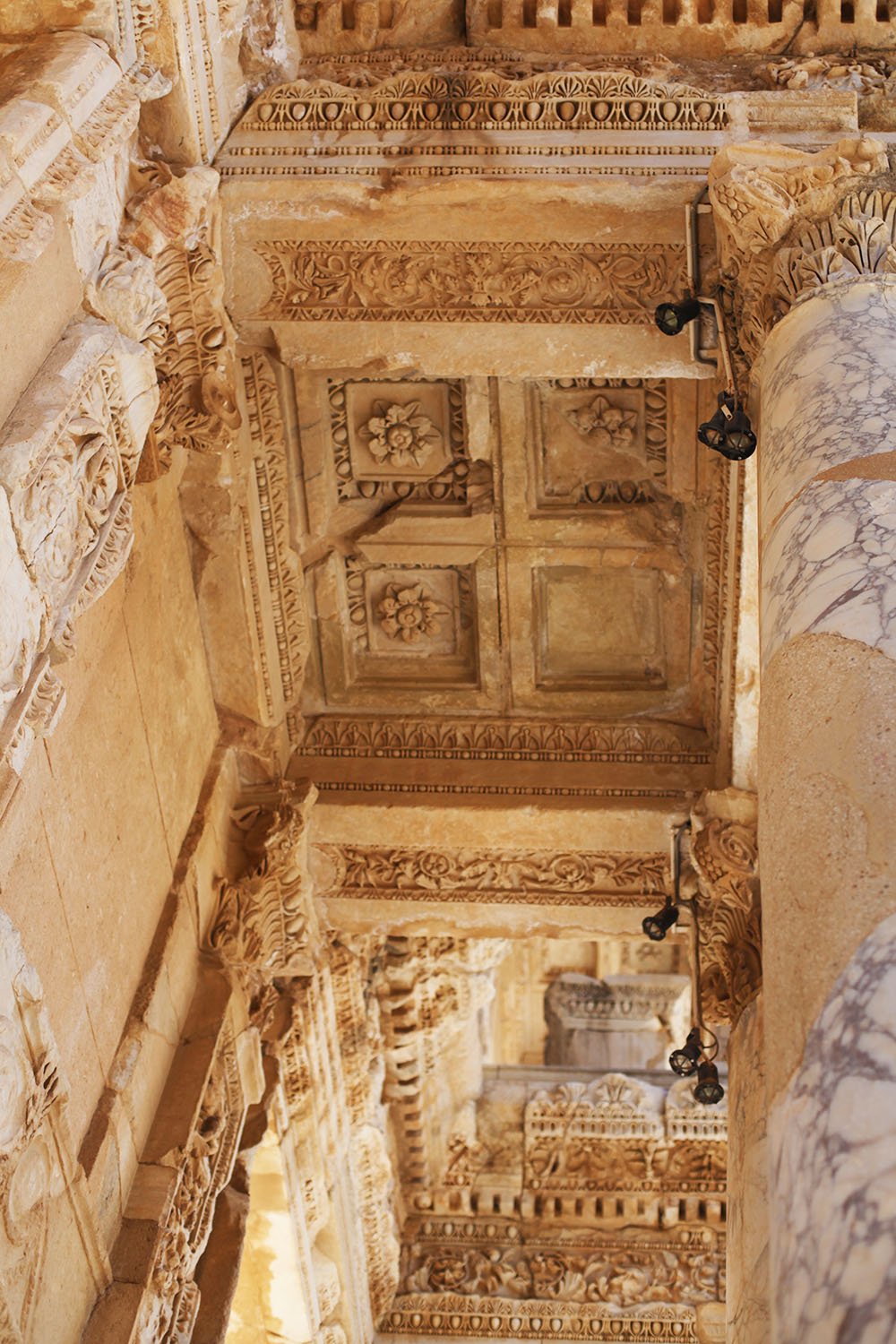

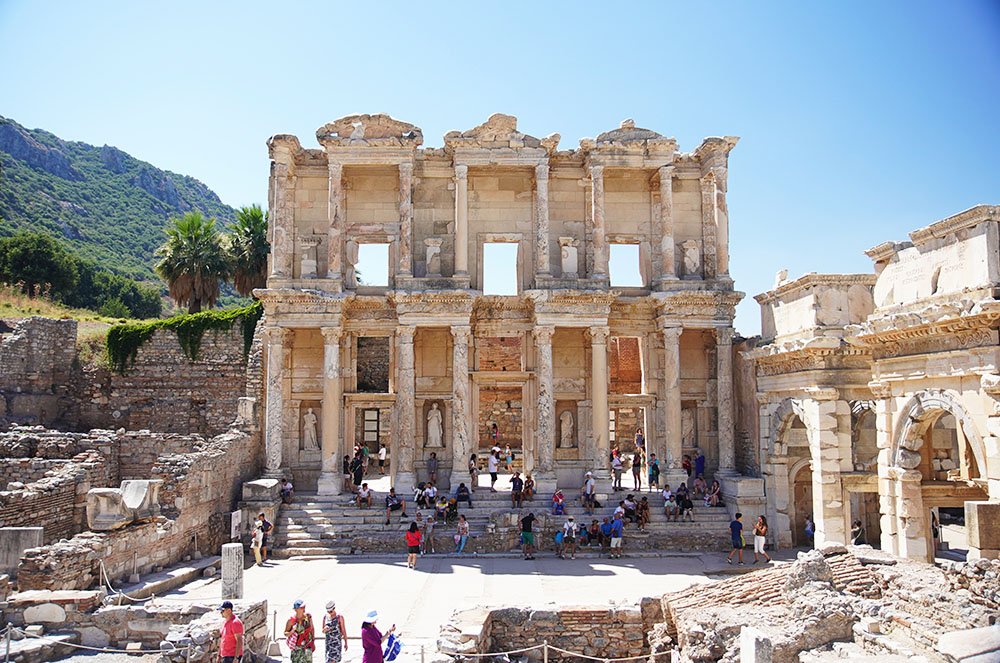

After around three hours, we finally make it to the last structure, but as they say, "last but not least" we have The Theatre. One of the most impressive buildings in Ephesus. Originally a Hellenistic theatre, it was later restored into a Roman style and could seat over 24,000 people.
Believe it or not, the population of Ephesus once stood at a staggering ~250,000. As such, it became the capital of the province of Asia Minor.
Such a theatre would have been used for performances but also demonstrations of social, political and economical nature. It was also frequently used for gladiator games in the Roman times.
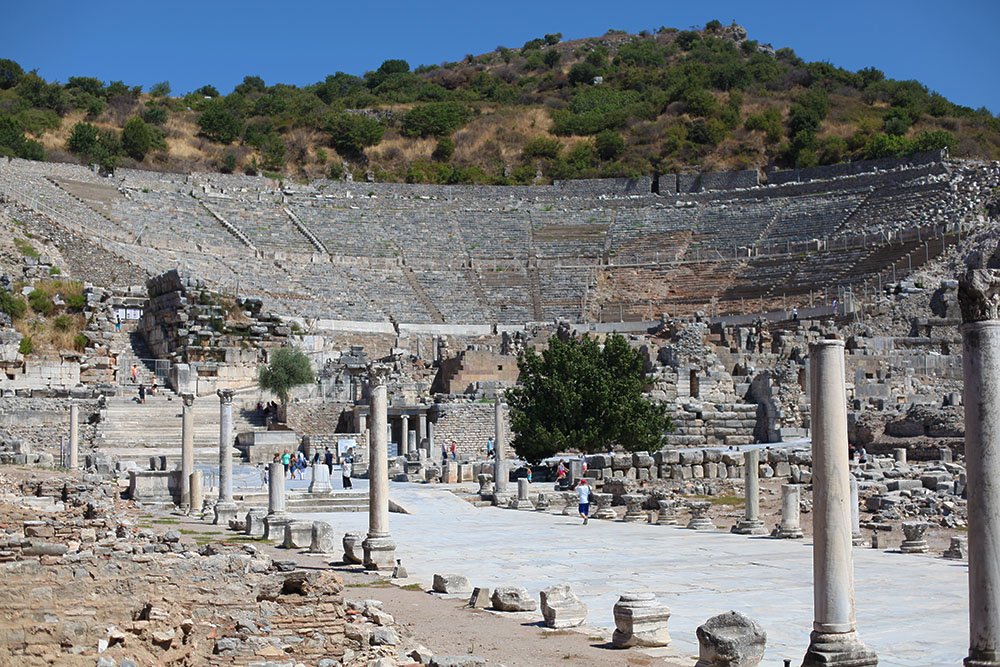
The theatre was originally two stories in height and was further heightened by the Romans at a later date.

Notice how the theatre leans on the side of a hill, this is how theatres were built in the Hellenistic period. It was the Romans who later invented free standing walls and thus the emergence of theatres which did not lean on the side of a hill.
By this point, I was extremely exhausted but an obligatory snap from the top of the steps to show just how big the theatre is was a necessary evil. I hope you enjoy the view!

Check out my video for some extra clips!
During my visit to Ephesus, I was approached by a very friendly German man who was interested in where I blog. He even asked me for my card! I realise I should probably get some Steemit cards to hand out but in the meantime I directed him to Steemit and hopefully he'll be interested in signing up!
Thank you for taking this tour of The Ancient City of Ephesus with me. I hope you enjoyed working your imagination in recreating the atmosphere of this ancient metropolis and at the same time picked up some interesting historical facts that perhaps you didn't know before!
As always, I appreciate an upvote if you liked my post, a follow if you want to stay up to date with my activities and please leave a comment to let me know what you think!
这一次来到土耳其,有机会可以在这里待2,3周时间,所以决定游历土耳其不同的城市,所以我制定了一条长长的路线。其中以弗所是我整段行程中最期待的地方。以弗所是古希腊人在小亚细亚建立的一座大城市,传说圣母玛利亚就终老于此,它位于浪漫的爱琴海河口,最初由雅典殖民者建立这个城市,现在归于土耳其所有。以弗所废墟是土耳其的著名的旅游点,当然也是我一直向往的一个地方,因为我非常喜欢有历史文化的地方,今天我就带着大家走进以弗所废墟,感受一下现存世界上最大、保存最完整的的古希腊、古罗马城池。
以弗所被称为土耳其的庞贝古城,曾拥有40万到50万居民,据说是当时世界上最大的城市之一。参观以弗所废墟,我要给你们2个温馨小提示,1是以弗所废墟,最好避开夏季,因为这里毕竟是一整个废墟的城池,所以并没有任何建筑可以为你遮阳,就连树荫都很少。这次我在炎炎夏日来到以弗所,真是吃了不少苦头,为了和朋友拍摄点好看的照片,在将近40多度的高温天气里,旋转跳跃不停摆姿势,拿着沉沉的相机,趴在地上,石块上不停拍,感觉不仅我要晒化了,相机也快化掉了。2是以弗所废墟有上下两个入口,一高一低,我的建议是从从上入口进,一路下坡路,确实非常省力气。别看这是废墟,我们连玩带拍,也花了小3个小时时间,到最后很热很累,已经快中暑了,火辣辣的土耳其阳光给我留下的纪念品,大概是现在接近炭黑的皮肤了。
以弗所古城主要分为3条大道,沿路都是历史遗迹,古罗马浴场,音乐厅,市集,图书馆,还有妓院,神殿和剧场,走上这条长长的道路,就好像进入了时空穿梭机,一下子回到了过去。首先看到的是古代时候,陶瓷制造的输水管,旁边就是古罗马公共浴场了,就连当今著名的土耳其浴也是由罗马浴池发展演变而来的。这么多大小石块堆砌成的庞大建筑一下子全部出现在眼前的时候,我被深深的震撼到。来到这里,你可以深切的感受到,历史就在身边。接下来是音乐厅,这个半圆形的庞大建筑出现在我眼前,我仿佛被施了魔法一样,看见了古时候人们排着队爬上音乐厅的楼梯的场景。这个音乐厅可以容纳1400人,看台后面是高墙,两边各有入口。与罗马式剧场建筑设计不同的是,这个音乐厅还搭建了屋顶,可以如今已经崩塌。我站在崩塌后的废墟旁拍了一张照,非常有意义的照片,我格外喜欢。市政厅已经看不太出原有的样子了,只是一些石头块上的图腾还清晰可见。
紧接着我们来到了土密善神殿和波里欧喷泉,还有胜利女神Nike的画像,据说这可以是知名运动品牌Nike原形呢。整个城池的经典大多围绕着这条克里特斯大道展开,昔日这条路直通港口,是运送木材和火苗的直通车。站在哈德良神殿门口,被拱门正中央胜利女神的头像照耀着光芒,感觉好极了。接下来来到的塞尔瑟斯图书馆,算是以弗所古城的地标建筑,照在这个巨大的图书馆面前,感觉太壮观了。最后这个领出门坡下大门口的大剧院,感觉比之前看到的音乐厅还要大一倍,虽然当时我看到音乐厅,已经被震撼的惊叹不已了。这个大剧院可以容下2万5千人,这个大剧院依旧是半圆形造型,建筑风格融合了希腊和罗马的特色。大剧院依靠山而建,非常像希腊的建筑特色,而那特色的圆形拱门,是十足的罗马建筑风格。在回去的路上,还有一路好奇追问的德国家庭,看我们一路认真的拍摄,非常好奇的询问了我们的摄影设备和我的博客地址,只是被问到名片的时候,有些遗憾,下次要做张Steemit的名片发放给感兴趣的人们,不过这一次旅行,让我有机会给全世界的游客宣传Steemit,迎来了全世界更多旅游博主的到来,可谓是收获不小。就这样,终于带大家走完了一整个古城的景点,希望大家喜欢这个汇聚了古希腊和罗马历史精华的古城,之后还有更多不一样的土耳其美景等着和大家分享。

